








By BODE RAMSAY
College Park’s newest ice cream parlor, Ice Cream Jubilee, will celebrate its grand opening in early August.
Known for its tall scoops and imaginative flavors, like banana bourbon caramel and passionfruit guava sorbet, the popular ice cream shop has three other locations in the District and Virginia.
“Ice cream makes people happy. It always does,” owner Victoria Lai said. “It’s such a gift to be part of a small business where you know that you can make somebody’s day a little better every time they walk through the door.”
Lai founded Ice Cream Jubilee in 2014 after she left her job as a government lawyer to start the business.
“We are so excited to be coming to College Park,” Lai said.
Lai said she’s been hearing for years about people traveling from College Park to the chain’s Navy Yard location for Jubilee ice cream.
Another unique option for a cold treat on a hot day sits on the edge of the University of Maryland (UMD) campus.
Class 520, the first Thai-inspired ice cream shop in Maryland, according to the company, offers a style of the frozen treat that grew in popularity in New York City.
“The thing that makes us unique is that we do rolled ice cream,” said Eldon Sloan, the owner of the store, located at



City
Area schools put city grants to work, P.2
Could teens vote in next local election? P.9
Neighbors volunteer to help neighbors, P.12
By KATELYNN WINEBRENNER
The City of College Park, since receiving almost $22 million in federal pandemic funding in 2021 and 2022, has spent the money to help residents pay bills, subsidize local businesses and invest in affordable housing.
The city received these funds through the American Rescue Plan Act (ARPA) of 2021, a pandemic-era economic stimulus measure. The U.S. Department of the Treasury gave $350 billion in Coronavirus State and Local Fiscal Re-
By LILLIAN GLAROS
Prince George’s County public school students will start their school days at 7:30 a.m., 8:30 a.m. or 9:30 a.m. in the upcoming academic year. Prince George’s County Public Schools (PGCPS) is changing start and end times for 78% of elementary, middle and high schools in an effort to reduce the frequency of school bus delays and create a more consistent schedule for pick-ups and drop-offs.
Lynn McCawley, PGCPS’ senior public information specialist, said the changes are part of an effort “to improve school bus transportation.”
For 62% of county schools, the change in the start and end of the day will shift by 15 or fewer minutes, according to PGCPS. Another 22% will
By KATELYNN WINEBRENNER
Eight local schools have received a combined $36,800 in grants from the City of College Park this year to fund educational projects of their choice.
The grant money will go toward an outdoor classroom, experiential learning opportunities and a pitch competition for aspiring student entrepreneurs, among other additions to the schools’ offerings.
“We are grateful for cities like College Park,” Cherokee Lane Elementary Principal Brian Galbraith said. “They give schools these opportunities to think outside the box.”
Eligibility for the College Park Public School Education Grant is determined by the number of College Park residents enrolled in the school.
Public schools with the most College Park students — called Tier 1 schools — that received funding are Hollywood Elementary, Paint Branch Elementary and Parkdale High. Each received $8,000. High Point High School was an eligible Tier 1 school but did not apply.
The Tier 2 schools enroll 14 or more College Park students. These include Berwyn Heights Elementary, Cherokee Lane Elementary, University Park Elementary and Buck Lodge Middle School. Each received up to $2,750 except for University Park Elementary, which received $2,834. Greenbelt Middle School was eligible but did not apply.
Because it is a charter school, College Park Academy does not fall within either category, but

A nationally-recognized community newspaper
chronicling the here and now of College Park.
Mailing address: PO Box 132, Hyattsville, MD 20781
College Park Here & Now is published monthly by Streetcar Suburbs Publishing., a 501(c)(3) nonprofit corporation. Editors welcome reader input, tips, articles, letters, opinion pieces and photographs, which may be submitted using the mailing address above or the email addresses provided. StreetcarSuburbs.News
is still eligible for $2,250, which it applied for and received.
Cherokee Lane used its grant money to purchase portable picnic tables and canopies to furnish an outdoor classroom.
The school already owns raised flower beds that it will place in the space.
“The outdoor classroom will allow our children to explore and discover the world around them in ways that a traditional classroom simply cannot,” Cherokee Lane Elementary Assistant Principal Kayla Newsome said.
“Utilizing any extra space that we can, truly has been very, very beneficial,” Galbraith said.
“Next year, we are projected to have 824 students, so we are definitely packed to capacity,”
If Cherokee Lane continues to receive grants like this, Galbraith said, the school might add a greenhouse to grow vegetables to hand out to students and their families.
Other schools, like College Park Academy, used the funds to support experiential learning opportunities.
The charter school offers students a chance to participate in their choice of six signature programs, with academic tracks similar to a college major.
Bernitta Johnson, the former coordinator of the signature programs and adviser of the business program, used the funds to pay for the costs of partnering with WETATi Academy, a leadership organization located on the University of Maryland campus that mentors low- and moderate-income students.
Based in the Nyumburu Cul-
Managing Editor Sharon O'Malley sharon@streetcarsuburbs.news
Interim Associate Editor Sam Gauntt sam@streetcarsuburbs.news
Columnists Paul Ruffins, Kit Slack
Contributors
Lillian Glaros, Madison Korman, Bode Ramsay, Katelynn Winebrenner
Layout & Design Editors
Ashley Perks, Valerie Morris
Web Editor Jessica Burshtynskyy
Advertising advertising@streetcarsuburbs.news
301.531.5234
tural Center on the University of Maryland campus, WETATi Academy helped prepare students for its Dureke iDEA Pitch Competition, similar to Shark Tank, for students to create and present their business plans to win scholarships or grant money.
In the future, College Park Academy advisers hope to find other community partners like WETATi to offer programs with the same experiential learning opportunities, Johnson said.
University Park Elementary is using its grant to help with changes in student behavior since the pandemic.
The money has funded extra professional development for teachers and staff as well as new tools and toys like earmuffs or weighted teddy bears for its calming room, where teachers send children to regulate their emotions.
Parkdale High School plans to use its $8,000 to fund a STEM field trip to Six Flags, where students will get to see real-world applications of engineering and physics through roller coasters and other park rides.
Paint Branch Elementary is also planning to use its funding for field trips, perhaps to the Maryland State House and the Smithsonian National Museum of Natural History.
Buck Lodge Middle School used the money to fund positive behavior reinforcements. According to its application, students who display good attitudes and academic achievement can earn points to exchange for T-shirts, passes to school dances, field trips or lunch with the principal.
Advertising Sales Manager Miranda Goodson
Business Manager Catie Currie
Executive Director Kit Slack
Board of Directors
President: Marta McLellan Ross
Vice President & General Counsel: Michael Walls
Treasurer: Joe Murchison
Secretary: Melanie Dzwonchyk
Bette Dickerson, Nora Eidelman, Joseph Gigliotti, Maxine Gross, Merrill Hartson, T. Carter Ross, Stephanie Stullich
Ex Officios: Katie V. Jones, Griffin Limerick, Sharon O'Malley, Kit Slack
Circulation: Copies are distributed monthly by U.S. mail to every address in College Park. Additional copies are distributed to popular gathering spots around town. Total circulation is 9,600.
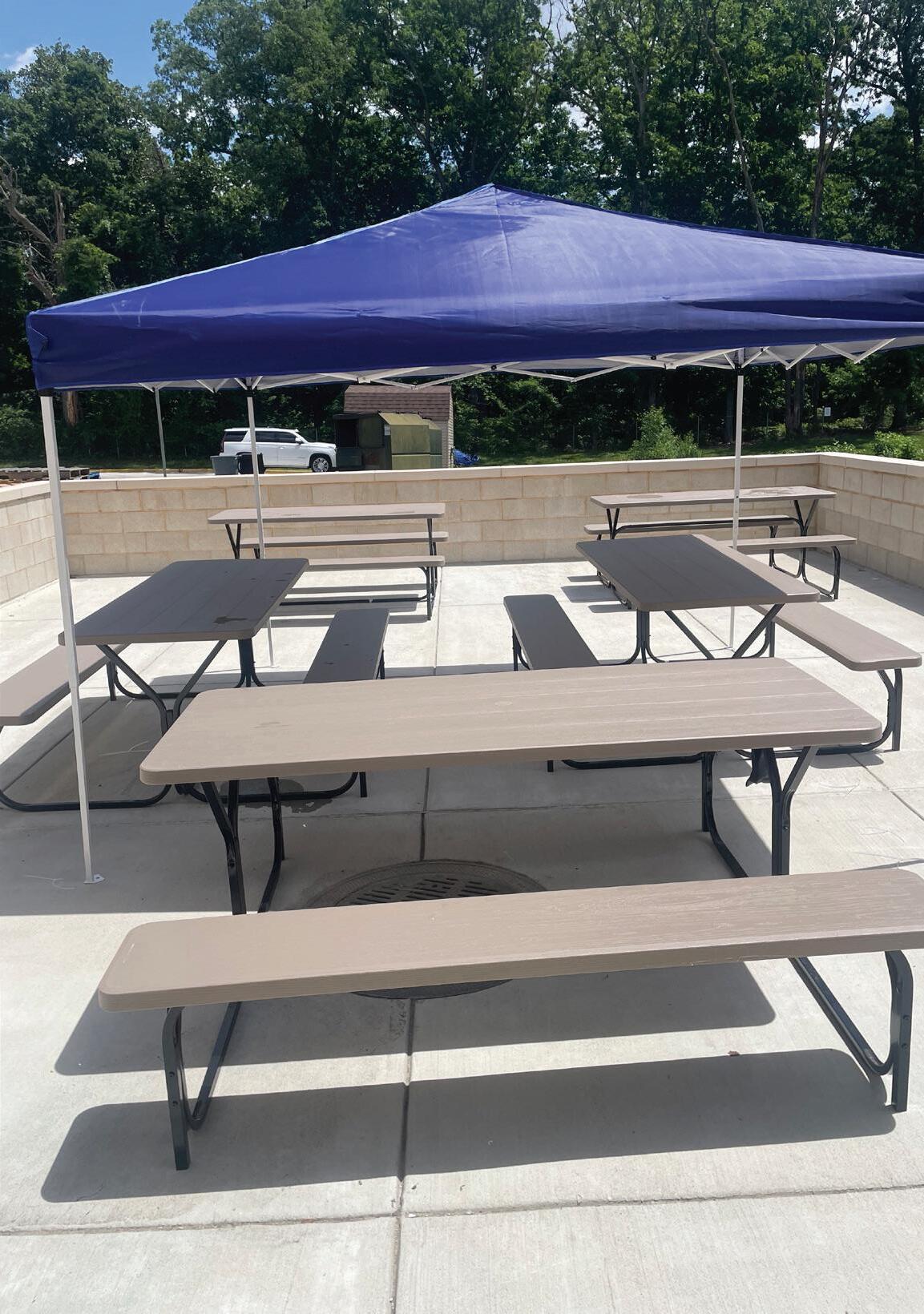
While some schools used the funding for unconventional programs, others, like Hollywood Elementary, focused on traditional goals like parent engagement. The school purchased language translation devices for parent-teacher meetings and information nights.
At Berwyn Heights Elementary, staff plans to focus on
student well-being with new uniforms, coats and hygiene products.
The city has funded projects like these through the grant program since 2008, but this year it received the highest number of applications in five years, Kiaisha L. Barber, the city’s director of Youth, Family and Senior Services, said.
Streetcar Suburbs Publishing is seeking an associate editor for this newspaper, the College Park Here & Now.
The associate editor supports the managing editor, and works with other paid staff and volunteers to put together our monthly print newspaper and contribute to our web content. The associate editor writes the community calendar page of the newspaper, works with our columnists, copyedits, and writes one to two articles per month. This position is home-office based with flexible hours and requires some weekend and evening availability.
For more information, please contact kit@streetcarsuburbs.news
To apply: Email kit@streetcarsuburbs.news with a resume, cover letter, two writing samples and two professional references by August 15. Please put "Application: Associate Editor" in the subject field.
By SAM GAUNTT
The College Park City Council recommended in July that the county approve a four-story, eight-unit apartment building on Autoville Drive.
The project, which the Prince George’s County Planning Board approved on July 18, will replace a single-family home, at 9621 Autoville Drive, south of Cherry Hill Road, in north College Park. The planned multifamily structure will be built in a two-over-two architectural style, with each two-story apartment sitting on top of another double-level unit.
The owner of the house initially planned to include 10 units in the new building, but later agreed to commit to eight units during discussion with the city council.
During a meeting on July 9, Councilmember Alan Hew (District 1) praised the property’s owner for being receptive to the city’s suggestions for the project.
“It’s rare that we have an appli-
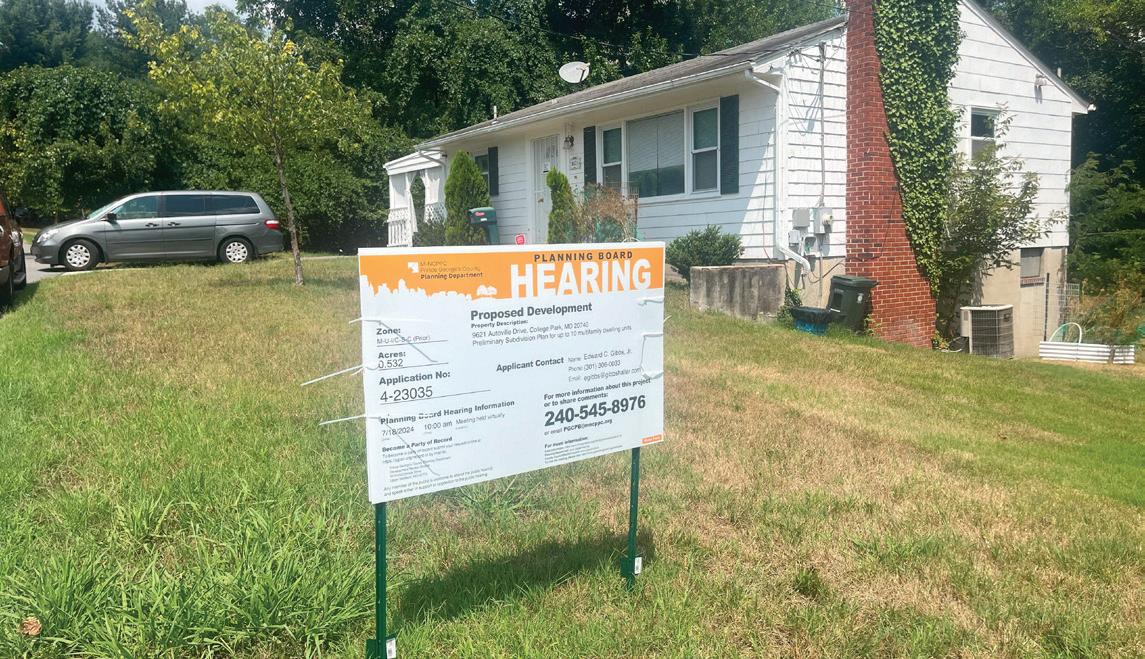
cant that’s so cooperative to the conditions put on them,” Hew said during the meeting. “What they’re proposing [10 units] is permitted under the zoning laws. [But] they’ve agreed to reduce the density and provide … more parking than required and utiliz[e] permeable paving in uncovered areas. There’s a number of things.”
Hew added: “They’ve decided to do the right thing and cooper-
ate with all these conditions.”
Several Autoville Drive residents spoke against the plan at the meeting, citing its potential disruption to their quiet neighborhood.
Approximately 10 people submitted letters to the city council before the meeting urging the council to oppose the planned redevelopment.
“I always tell people, ‘Hey, come on up here and live with
us; don’t come up and destroy it,’” James Woodhouse, who lives on Autoville Drive, said during the meeting.
College Park Mayor Pro Tem Denise Mitchell (District 4), who cast the sole vote against the project, raised concerns about its potential disruption to the majority single-family home neighborhood.
“I will be voting no regarding this project due to the fact that it will change the character of the community, the quality of life of the residents,” Mitchell said.
Mitchell added the community on Autoville Drive is “not like other areas in [the] City of College Park. It is truly unique and truly different.”
City Councilmember John Rigg (District 3) supported the project, saying it is “the sort of development that we should be embracing in the City of College Park.”
“I can tell you that you can still have a vibrant community, you still have a great community, you still have a peaceful community,
even with renters in it, even with people who live in apartments in it,” Rigg said at the meeting. “I would urge us to not get blinded by status quo bias in this particular case.”
According to the property’s lawyer, Edward Gibbs, the owner will rent the apartments to graduate students and College Park residents but will avoid renting to undergraduate students.
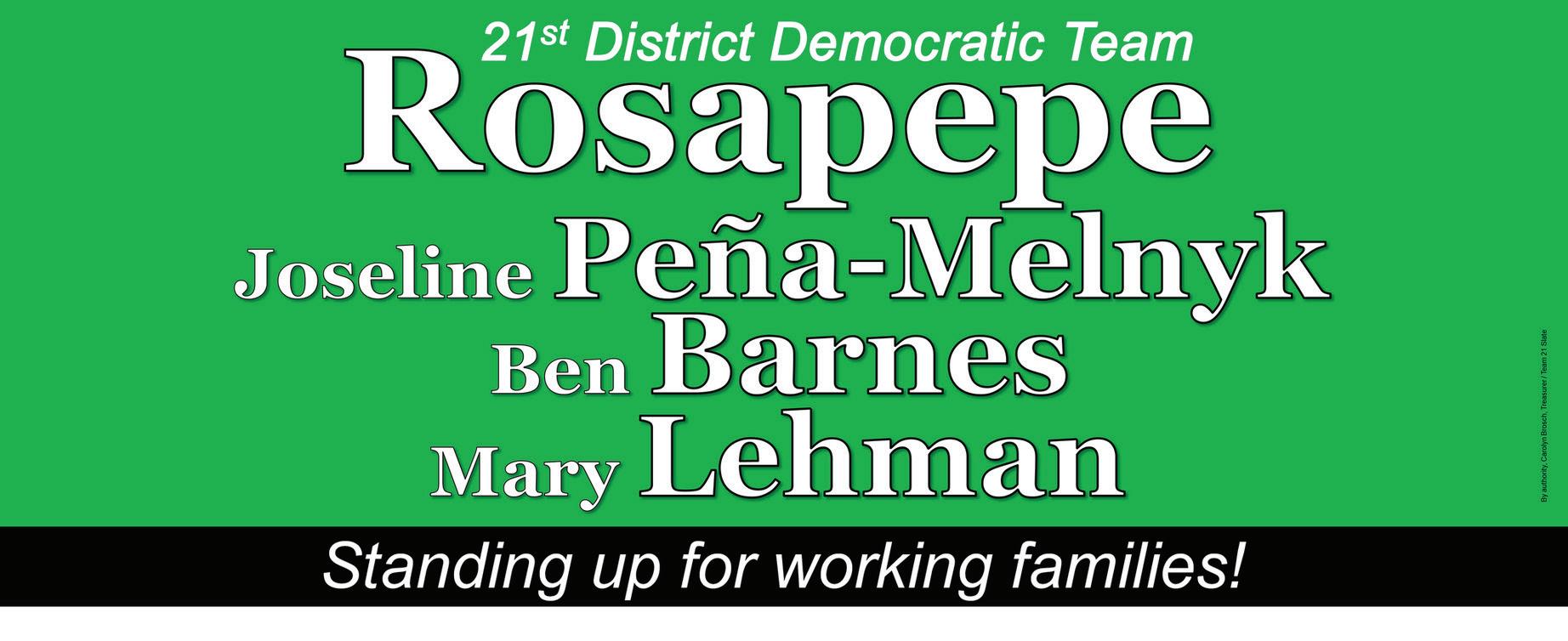
“She’s targeting to lease to the general public,” Gibbs said of the property’s owner, Josiane Alagbe. “She just doesn’t want to ever have any undergraduates there because of the immaturity level. I mean, [I] hate to say that, but that’s it.”
Gibbs added the development will contain two units of affordable housing, with the rest being rented at market rates. He said the owner will work with the city to determine how to price the affordable units.
City councilmembers recommended the project with seven conditions.


By KIT SLACK
Streetcar Suburbs Publishing, the nonprofit that publishes this newspaper, approved our first strategic plan on June 27. Over the next five years, we will strengthen and connect three distinct, diverse communities in Prince George’s County — Hyattsville, College Park and Laurel — through high-quality local journalism.
This year marks our 20th anniversary. We started in 2004 as Hyattsville Community Newspaper, Inc., publishers of Hyattsville Life & Times — a tiny paper that, nonetheless, frequently won national awards.
From the beginning, we have focused on celebrating the civic organizations that bring people together in our communities, and on providing the information that allows community participation in local, municipal democracy. Four years ago, during the pandemic, College Park residents started College Park Here & Now under our nonprofit umbrella, and we became Streetcar Suburbs
Publishing, Inc. And in 2022, a committee of volunteers in Laurel helped start The Laurel Independent, our third newspaper.
In 2023, we conducted an internal review that led to the hiring of our first executive director (that’s me). Over the past year, we built on that review to develop our strategic plan, studying local journalism needs in our area and working together to identify opportunities within our organization to grow our revenue, expand our service and support our staff.
The strategic plan we created is already in motion. We have chosen four key priorities to focus our work:
• Providing in-depth local journalism to reach audiences wherever they are
• Deepening community connections, including exploring how we can better serve Spanish-speaking residents
• Growing our financial sustainability to invest in our staff and in local journalism
• Investing in staff across all levels of the organization — our greatest asset.
Priority 1: Provide in-depth local journalism to reach audiences wherever they are. To accomplish our first priority, we are investing more in covering city government and community organizations, our core coverage focus. We are strengthening our digital services, in particular our social media presence, so we can meet residents more fully in the places they go looking for news and information. And to address the gap that has grown as other sources of county news have dried up, we are expanding our coverage to include countywide issues affecting residents of Hyattsville, College Park and Laurel. We have also launched a bi-weekly email newsletter, with easy signup on our website.
Priority 2: Deepening community connections, including exploration of how we can better serve Spanish-speaking residents.
To reach new and underrepresented readers in our communities, our staff and board members will engage with diverse
By PAUL RUFFINS
As cities across the DMV and around the world become more concerned with traffic congestion and climate change, Uber and Lyft have been touted as better alternatives to everyone owning, driving and parking their own cars. But the devil is in the details.
In 2020, the Union of Concerned Scientists concluded that “ridehailing trips today result in an estimated 69 percent more climate pollution on average than the trips they displace.”
Recent years have seen a surge in e-bikes, and e-scooters in College Park, but how do these alternatives stack up? This article explores how each successive wave of micromobility devices solved old problems but created new ones.
After WWII, the most popular forms of micromobility throughout the world were individually owned bicycles and gas-powered motor scooters. Amsterdam’s
1967 experiment with completely free bikes failed; the local government opposed it and too many bikes were stolen.
By the 1990s, systems where riders unlocked bikes and later returned them to specific docking stations proved successful. In 2008, SmartBike DC became the first bike-sharing program in the nation, with 10 docking stations and about 100 bikes.
Riders loved it, but the docking stations were so expensive that SmartBikes folded. In 2010, Capital Bikeshare, a collaboration between the District and Arlington County, introduced more affordable docking stations and became a huge success.
Docked bike-sharing, which can be particularly useful for short trips — say, from home to work, school or public transit — has its limitations. Trips must begin and end at a docking station, and companies have to regularly collect and redistribute the bikes.
College Park was eager to join Capital Bikeshare but couldn’t
community leaders throughout our service area, networking one-on-one, attending community meetings and building partnerships. We also plan to have a more consistent presence at city forums and events, and to communicate with our readers throughout the year about the work of our organization so readers can get to know us better.
Priority 3: Grow financial sustainability to invest in our staff and in local journalism. In order to accomplish our first two priorities, we are already working to ensure our financial sustainability by increasing revenue from grants, donations and advertising. Our next step will be to conduct audience surveys so we can learn more about what you value about our service and build from there.
because the system was countybased, and Prince George’s hadn’t joined yet.
In 2016, the city contracted with mBike, which was run by a private company that used U locks and GPS, allowing users to locate and unlock bikes with their cellphones. A system upgrade soon allowed riders to leave their mBike at any bike rack, and the dockless revolution had begun.
Despite its initial success, mBike’s tenure in College Park was doomed by 2018, when UMD and the city approved dockless escooters and e-bikes. Companies like Bird and Lime had raced to introduce e-scooters nationwide, promising users a fun, convenient and pollution-free alternative to gas-powered vehicles.
Shared e-devices present two challenges: charging and durability. Collecting the scooters to recharge and redistribute every night uses fuel and generates emissions. And, in the rush to deploy e-scooters faster than their competitors, some companies
Here at Streetcar Suburbs, what we most love about our jobs is working with and for you, our readers, and we look forward to connecting with you even more as we go forward. Please subscribe to our new newsletter, The Streetcar Suburbs Spotlight, at streetcarsuburbs. news/subscribe. Keep an eye out for our reader survey, coming soon. And as always, send us your news tips and ideas, and consider donating to support our work. Thank you for joining us in this effort!

Kit Slack is the executive director of Streetcar Suburbs Publishing.
Priority 4: Invest in our people across all levels of the organization — our greatest asset. Our organization relies on board members who are strong nonprofit managers and organizational leaders; many of them are also news industry veterans. And we rely on staff who are brilliant writers and careful editors. As we increase our financial sustainability, we aim to better compensate our newsroom staff, and by growing deeper and broader connections in our communities, we are eager to recruit more voices from underrepresented communities.
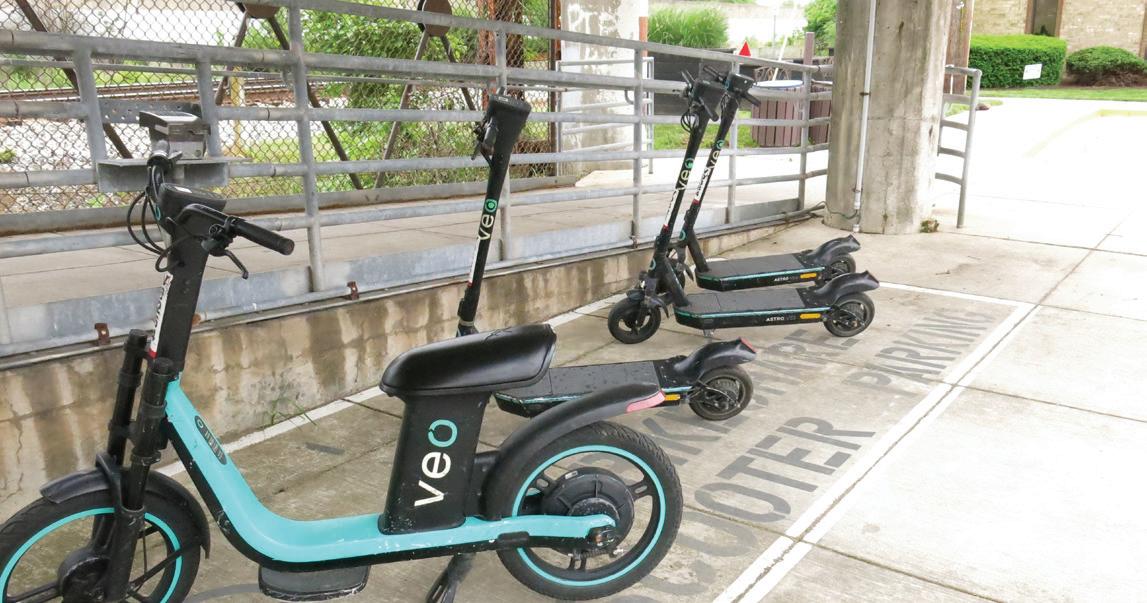
E-bikes and e-scooters have become fixtures around College Park and are convenient, but not as environmentally friendly as pedaled bicycles.
chose cheap models that quickly wore out and were discarded. These devices require a lot of valuable materials: powerful lithiumion batteries, and cellular and GPS technologies, that often landed in landfills.
Indeed, the waste was significant: A 2019 study conducted in North Carolina concluded that shared e-scooters produce more CO2 per passenger than a diesel bus with high ridership. In contrast, the Veo company was producing durable e-vehicles custom-designed for heavy commercial use. It also pioneered swappable batteries, which are much more efficient because every vehicle doesn’t have to be removed, recharged and returned every night. As a result, Veo won the contract to provide College Park (and neighboring University Park) with 150 e-bikes, 70 e-scoot-
ers and 70 traditional pedal bikes. Riders leave dockless vehicles to block sidewalks or create other nuisances. Veo tried geofencing their vehicles to continuously charge the bike or scooter until the rider turns off the rental in an approved location. But riders still left their e-bikes and e-scooters all over the place. So the benefits of Veo’s micromobility system have been reduced; when its contract with the two cities was renewed in 2020, the company stopped offering traditional pedal bikes. A system meant to replace gaspowered cars had rejected its cleanest healthiest choice: human-powered bicycles.
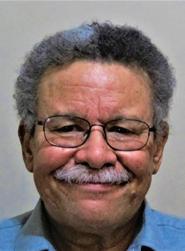
Paul Ruffins is a citizen scientist and professor of curiosity.
By SAM GAUNTT
University of Maryland (UMD)
graduate students will have a new housing option when the college’s planned Leonardtown apartments become available near downtown College Park in two years.
The 465-unit building, which will be located on the site of the now-demolished Old Leonardtown apartments on the east side of Baltimore Avenue, will offer another housing option for some of the university’s more than 10,000 graduate students. The development is slated for completion in August 2026 and will create a new street, Graduate Way.
Some city leaders said the project will have a positive impact not only on the university’s graduate students but on the city as well.
College Park City Councilmember John Rigg (District 3) said he’s enthusiastic about the project near Norwich Road and Rhode Island Avenue.
“It’ll be a vast improvement over the status quo,” Rigg said. “It’ll provide much needed housing at below market for some of our residents who have the most financial needs.”
The development will join two other graduate student housing complexes near campus: Graduate Gardens, on Rowalt Drive, and Graduate Hills, on Tulane Drive near Adelphi Road. Both are on university-owned properties and are operated by an independent management company.

It’s for everybody
• Adults and Youth
• Big boats and small
• Sign up now for our Fall lessons and programs
• The river is waiting for you
BEGINNERS WELCOME!
Some city leaders said the project will have a positive impact not only on the university’s graduate students but on the city as well.
Leonardtown apartments will not be as affordable as graduate students would like, the addition is still a plus “because we already have a scarcity of enough housing options for grad students.”
According to Edward Maginnis Jr., UMD’s assistant vice president for real estate, studio apartments in the Leonardtown development will rent for around $1,350 a month.
Some UMD graduate students earn stipends ranging from $26,304 over nine months to $36,446 for a year to conduct research or teach while they go to school.
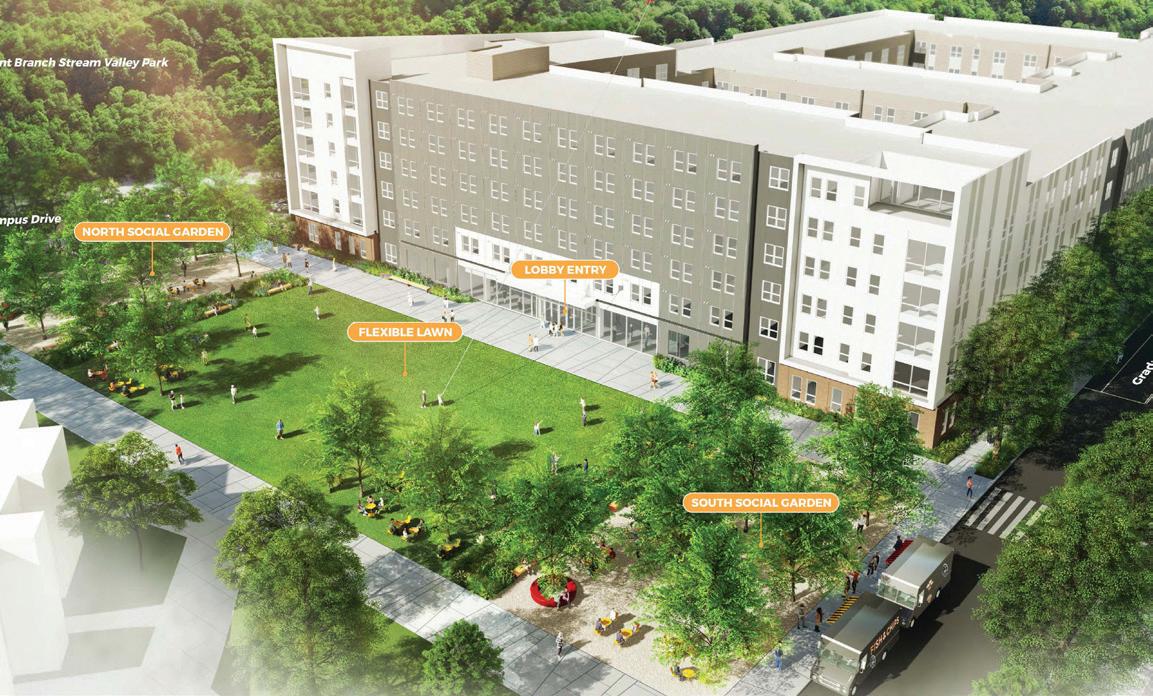
the deforestation of the woods. The university announced in October 2021 that it would not develop the land.
The Courtyards, an apartment complex near the Xfinity Center, houses undergraduates and has some units reserved for graduate students as well.
Varaa Kukreti, the new president of the UMD’s Graduate Student Government (GSG), said the project is a “step in the right direction” for graduate student housing.
“The demand is very high for affordable housing or places which are relatively cheap, like Graduate Gardens and Graduate Hills,” Kukreti, an engineering and cybersecurity graduate student, said.
Kukreti added while the new
City Councilmember Stuart Adams (District 3) said the Leonardtown project is “absolutely the type of development that we’ve been asking for in College Park.”
“I think it’s pretty much a home run in terms of aligning with what the community, both university and long-term residents, are asking for,” Adams said.
The university initially sought to build a graduate student housing complex, Western Gateway, on the south side of campus.
That development was slated for a parcel in Guilford Woods, just below campus. The plan was derailed when students and community members protested
At that time, UMD President Darryll J. Pines and former GSG President Tamara Allard said in a statement that the university would “continue to listen, learn and adapt plans to address the critical need for graduate housing.”
Adams said the Leonardtown development shows the university is listening to the students and residents who want more affordable housing that is close to the campus and the Metro station, but doesn’t require deforestation of the designated site.
Rigg said bringing another graduate student housing complex to the city may help local businesses with what he called the “eight-month economy.”
During academic breaks over the summer and winter, Rigg said, many local businesses struggle when undergraduate students leave College Park.
“I think it will increase the number of residents who are living in the town year-round, which is a long-term goal of the City of College Park, to kind of increase that 12-month population,” Rigg said. “I think this helps in that regard.”
In a May 7 presentation to the city council, Maginnis said for a long time, the university has had only 750 beds for graduate students in its housing complexes.
“The graduate student community has been underserved in that way,” Maginnis said during the presentation. “This is a really fantastic product.”
The Leonardtown development will include more than 200 parking spaces, multiple charging stations for electric vehicles and 120 spots for bicycles.
“We’re heading in the right direction,” Adams said. “It seems to be very much appreciated by the grad students in the community. It seems to align with what the community is looking for as well — the larger community.”

I've
Call or email me for a free consultation and let me put my expertise and enthusiasm to work for you! YOU TOO CAN ROW
Want to know more?
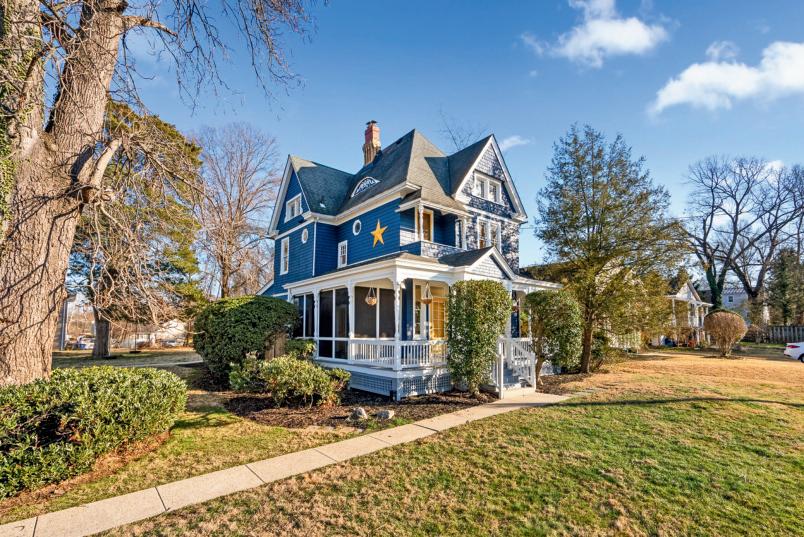
All activities are at Bladensburg Waterfront Park
4601 Annapolis Road, Bladensburg WashingtonRowingSchool.com 202-344-0886








By SHARON O’MALLEY
Going out of your way to find a shady path to walk on or opening an umbrella on a cloudless day to keep the sun off your face could not only make you more comfortable, it could keep you safe during a heat wave.
Climate experts at the University of Maryland (UMD) told College Park Here & Now it’s important for anyone who ventures outdoors to take precautions on unusually hot days, and it could be critical for those who suffer from asthma, or heart or kidney issues.
“It may even be worthwhile to go slightly out of your way to make sure you are walking in a comfortable space,” said Chester Harvey, director of the Transportation Policy Research Group at UMD’s National Center for Smart Growth. “Or things like carrying water or carrying an umbrella to shade yourself. This is something that’s fairly common in other countries — carrying an umbrella not for rain, but for shade.”
July was the second-hottest month on record in Baltimore,

If you have to be outdoors during a heat wave, find shady paths to walk on and seek out covered bus stops that will limit your exposure to the sun while you wait for your ride. ADOBE STOCK PHOTO
according to the National Weather Service (NWS), with an average temperature of 82.2 degrees. Temperatures reached 100 degrees or higher on half of the days in July. And heat indexes along the Chesapeake Bay reached 110 degrees at least once last month, the NWS reported.
That record is a textbook example of what climate experts classify as a heat wave, said Amir Sapkota, a professor and chair of UMD’s Department of
Epidemiology and Biostatistics, who focuses on how climate change affects human health.
“When these unusually hot days happen together, two, three, four at a time, that’s what we call a heat wave,” Sapkota said.
That level of heat is harmful in multiple ways, Sapkota said.
“Heat is a killer,” he said. “Heat stroke, heat exhaustion … those are easy to see and it’s immediate. But that’s not the only thing. There are so many other

… indirect impacts.”
Prolonged bouts of stifling heat, Sapkota said, increase ozone concentration, which can irritate the lungs and trigger shortness of breath, coughing and lung infections. It also promotes drought, which contributes to wildfires, which produce pollutants that can travel for thousands of miles and irritate those who suffer from respiratory and cardiovascular illnesses.
Even healthy people can fall ill during a heat wave, said Sapkota, who recommended drinking extra water, minimizing outdoor activity during the sunniest and hottest parts of the day, and seeking out airconditioned indoor spaces.
Harvey said workers who commute to their jobs should consider public transportation, which typically is air conditioned, or even drive their airconditioned cars to keep themselves safe and comfortable, even though that might not be the best choice for the environment.
For those who walk to a bus stop, finding a shady path and
a covered shelter to wait under are key ways to stay out of the sun.
“People need to take care of themselves,” Harvey said. “If that means that the only safe thing to do during a heat wave is to drive, then that’s what they need to do. We need to realize that people have limited choices and can’t always make [environmentally conscious] decisions in terms of what to do in a heat emergency.”
Still, drivers can make fewer trips, combine errands with their commute and request telework days to reduce their mileage and their greenhouse gas emissions, Harvey suggested.
Most important, Harvey added, is for everyone to “recognize that it is dangerous. It’s a real threat. It can make you sick. … It’s not something to just take lightly. Heat exposure can be a danger to your health.”
He added: “We all tend to think that we are immune to” heat-related illnesses, “that it is not going to happen to me. It’s for someone else. They are weak. But it can happen to you. It can happen to your family.”
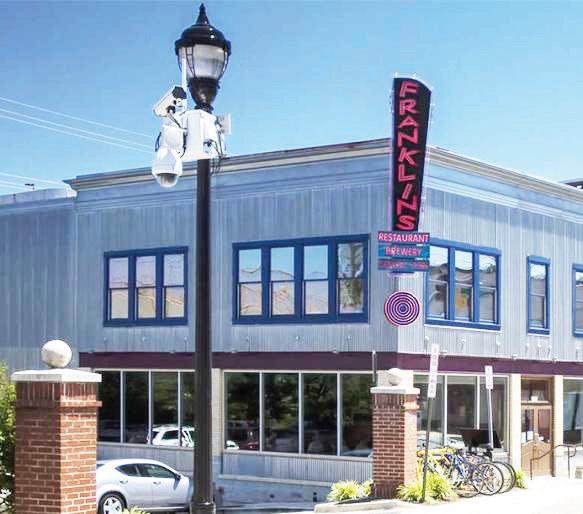

In our bustling City, noise can be a persistent and sometimes overwhelming presence. From early morning leaf blowers to midnight karaoke enthusiasts, the soundtrack of City life is inescapable.
Help us turn down the volume on neighborhood noise and find the sweet sound of serenity! This article explores the impact of noise, the City’s efforts to control it, and what you can do to create a more peaceful neighborhood.
According to Harvard Medicine School, noise pollution causes hearing loss, tinnitus, and hypersensitivity to sound and can also worsen cardiovascular
to harmonize with the neighborhood by turning down the volume on noise
disease, diabetes, sleep disorders, mental health, and childhood learning. For our community, ensuring a quieter environment is critical for the well-being of ourselves and our neighbors.
EFFORTS TO CONTROL NOISE
Through several initiatives and policies, the City aims to minimize noise pollution through:
• Noise ordinances that regulate noise levels, particularly during nighttime hours. (8AM-8PM: 65 decibels, 8PM-8AM: 55 decibels)
• Construction regulations to limit noise on-site and minimize the impact to nearby residents.
CREATING QUIET
Everyone plays a part in maintaining a peaceful neighborhood. Help reduce noise by:
• Being considerate when hosting events or playing music, especially during later hours.
• Use soundproofing, such as thicker carpets, curtains, or even specialized panels to decrease the amount of noise that travels.
For all noise violations, call the Code Enforcement Hotline at 240-487-3588 or visit www. collegeparkmd.gov/tellus.
Residents can also submit written
noise complaints to the Noise Control Board; if two or more residents file a written complaint for a specific noise disturbance, the Noise Control Board will then hold a hearing to determine whether a violation has occurred.
Noise complaints should be sent to the College Park Noise Control Board at 7401 Baltimore Avenue Suite 201, or via email to publicservices@collegeparkmd. gov within 15 days of the event.
Violations of the City’s Noise Ordinance is punishable by fines.
For more information on our noise control efforts, and how you can help, visit www.collegeparkmd. gov/goodneighbor.
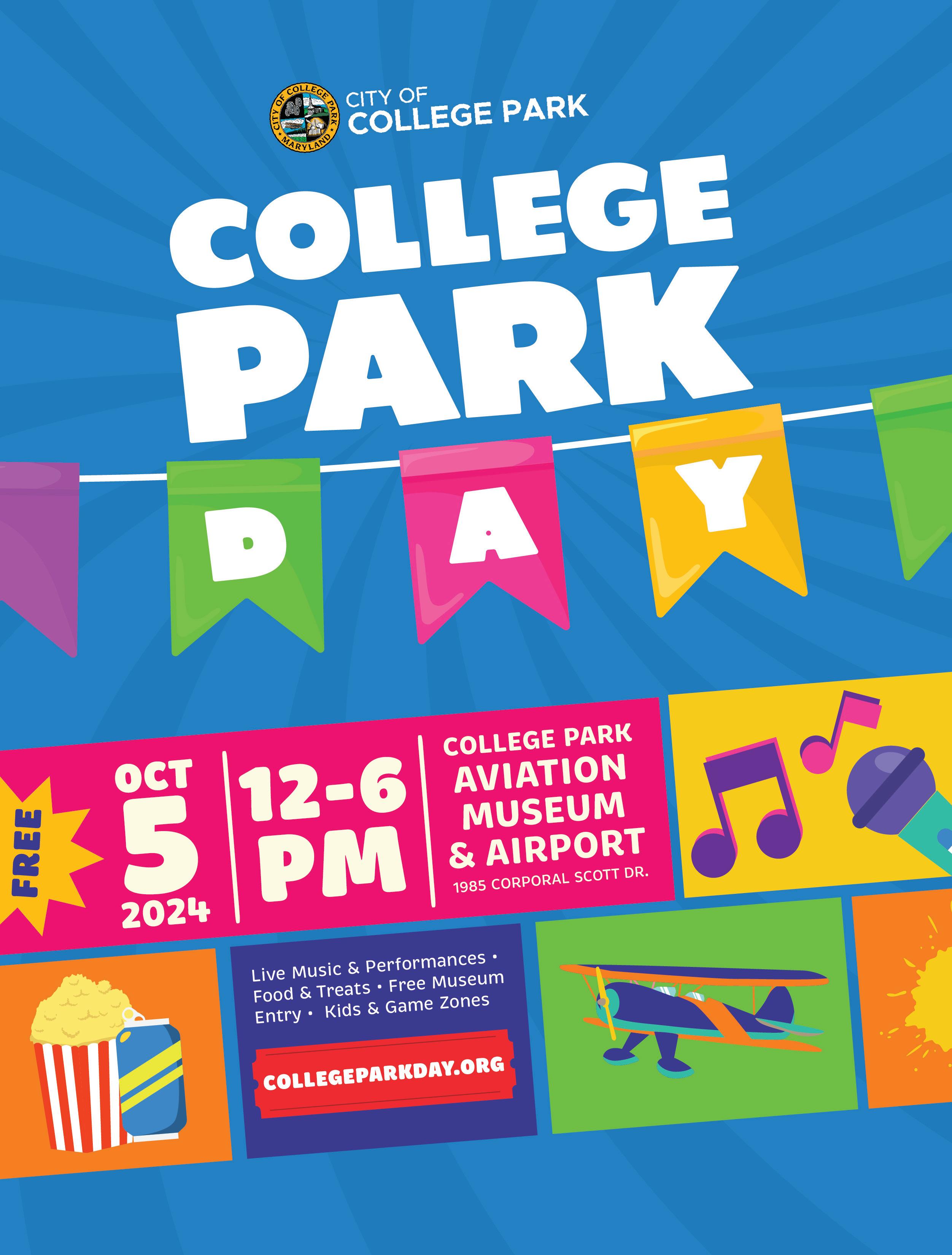
Apply by September 15, 2024
The City of College Park’s NeedsBased Student Housing Subsidy Pilot Program is now accepting applications! Approved by Council in April, this new pilot program provides a one-time grant of $1,250 for housing assistance to 60 eligible undergraduate and 60 eligible graduate students.
To qualify, the students must live within the boundary of the City of College Park; be enrolled full-time at an accredited post-secondary institution located in the D.C. metropolitan area; and be eligible for Pell grants (undergraduate students) or have an income below 60 percent of the HUD 2024 Adjusted Home Income Limits for the D.C. metropolitan area (graduate students).
All applications are due by September 15, 2024. To apply, visit www.collegeparkmd.gov/ studenthousingsubsidy. For any questions or concerns, please email financedepartment@ collegeparkmd.gov.
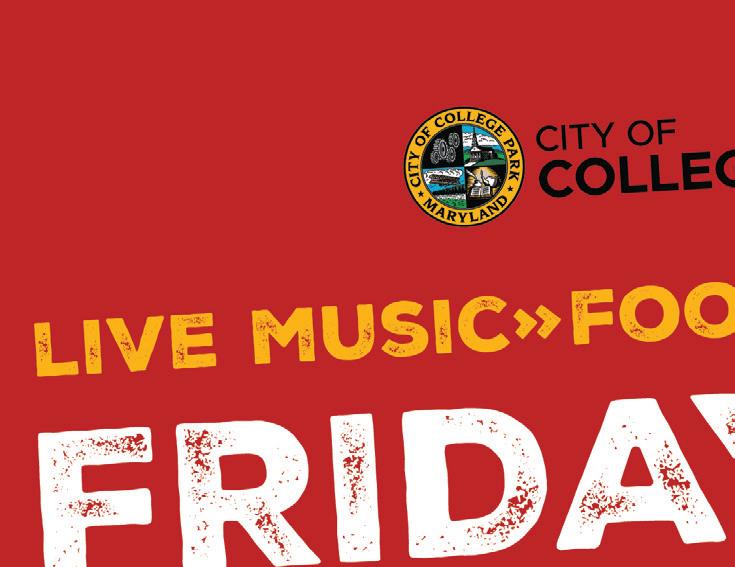
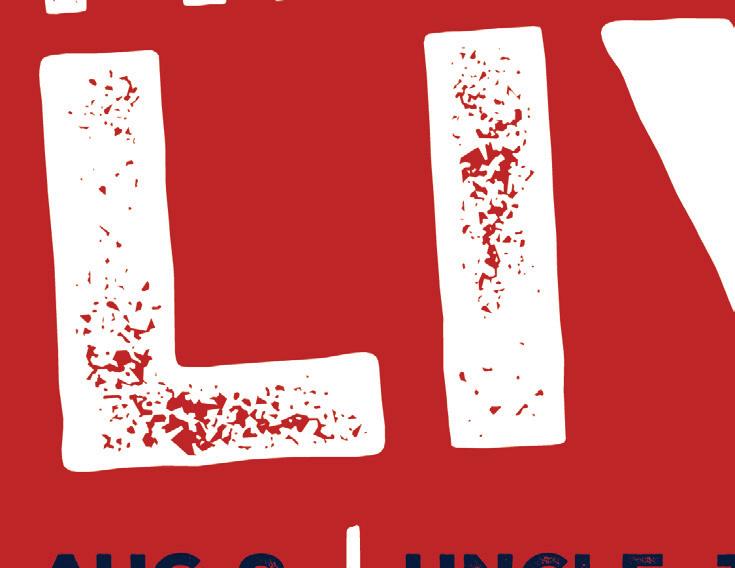



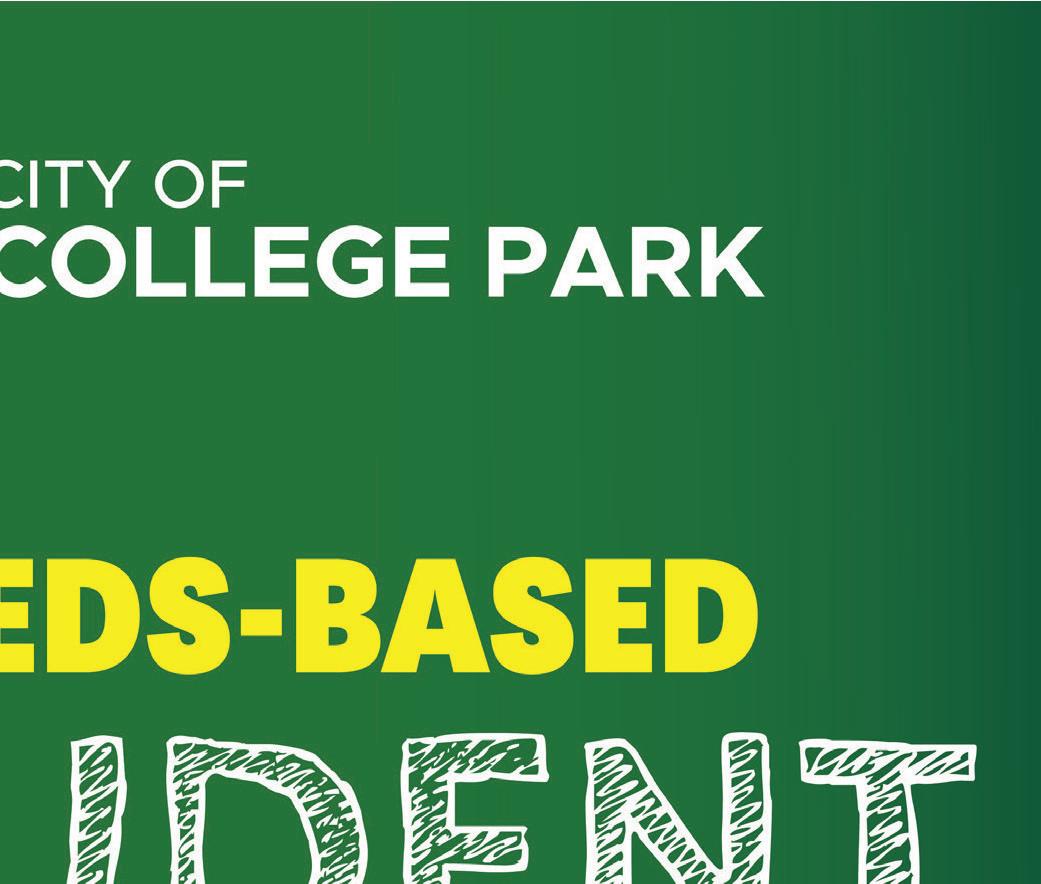





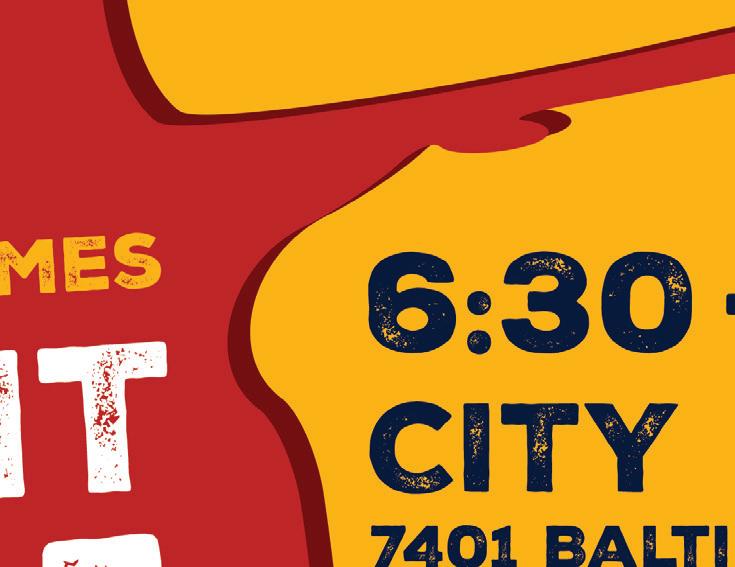






All City of College Park offices will be closed on Monday, September 2, 2024 in observance of the Labor Day holiday. Refuse and recycling will occur one day later than normal during this holiday week:
• Monday collections will occur Tuesday, September 3
• Tuesday collections will occur Wednesday, September 4
• Wednesday collections will occur Thursday, September 5
Special collections for brush and bulky items will only be scheduled for Friday, September 6, of this holiday week. You must call 240487-3590 or email publicworks@ collegeparkmd.gov to schedule a pickup before setting your items out to the curb.
Effective starting FY 2024, the City of College Park will provide a $150 credit of the City portion of the property tax bill, for up to 5 years. To be eligible for this credit, you must meet all of the following criteria:
1. At least one homeowner is age 65 or over by June 30, 2024 AND
2. the eligible homeowner has resided at the property the
More information: www.collegeparkmd.gov
credit is sought for at least the previous 10 fiscal years AND
3. the assessed value of your property does not exceed $515,000 on July 1 (adjusted July 1, 2024 for new applicants by the lesser of the CPI or 3%).
4. Applications must be received by October 1, 2024.
Learn more and apply at www.collegeparkmd.gov/ elderlytaxcredit25.
Visit downtown College Park for FREE this summer! Until August 17, park for free in the Downtown Parking Garage on weeknights after 5pm and all-day on Saturdays and Sundays. Explore all the amazing dining, shopping, and entertainment options our City has to offer. See you downtown!
Warm spring weather can cause mosquito larvae to become active, producing adult mosquitoes. The Maryland Department of Agriculture (MDA) will begin applying mosquito larvicide control products to standing water in known breeding areas to prevent the development of larvae into biting adult mosquitoes.


The adult spray portion of MDAs program is scheduled to start in late May/early June and run through September to trap and control mosquito populations. More information can be found on our website www.collegeparkmd. gov/mosquito.
Residents can request exclusion from the adult spray program by completing an exemption form annually and return it to:
Program Supervisor, Mosquito Control Section 50 Harry S. Truman Parkway Annapolis, MD 21401
If you don’t have a printer, the local office for MDA Mosquito Control in College Park has offered to send residents a form via DocuSign. Send an email to skeetermd1. mda@maryland.gov to request the form be sent via DocuSign.
Visit the MDA’s Mosquito Control website (https://mda. maryland.gov/plants-pests/ pages/mosquito_control.aspx) for more details about the program, including their policy, insecticides used, product labels and material
safety data sheets (MSDS), and more.
The City is seeking a part-time Contract Secretary to attend and record evening Board and Committee meetings.
This position requires a reliable person with strong grammar and secretarial skills to prepare a summary of the proceedings, make approved revisions, and provide a final set of minutes in a timely manner.
This assignment does not require word-for-word reporting. Meetings are conducted by Zoom or at public facilities in College Park on weekday evenings.
Contract rate is $25.00 per hour, guaranteed two hours per meeting, plus preparation of minutes at $12.50 per half-hour. We estimate six to twelve hours per month to start, depending upon Committee assignments.
Please submit cover letter and resume to: College Park City Clerk’s Office, 7401 Baltimore Avenue, Suite 201, College Park, MD 20740, or email cityclerk@collegeparkmd. gov.
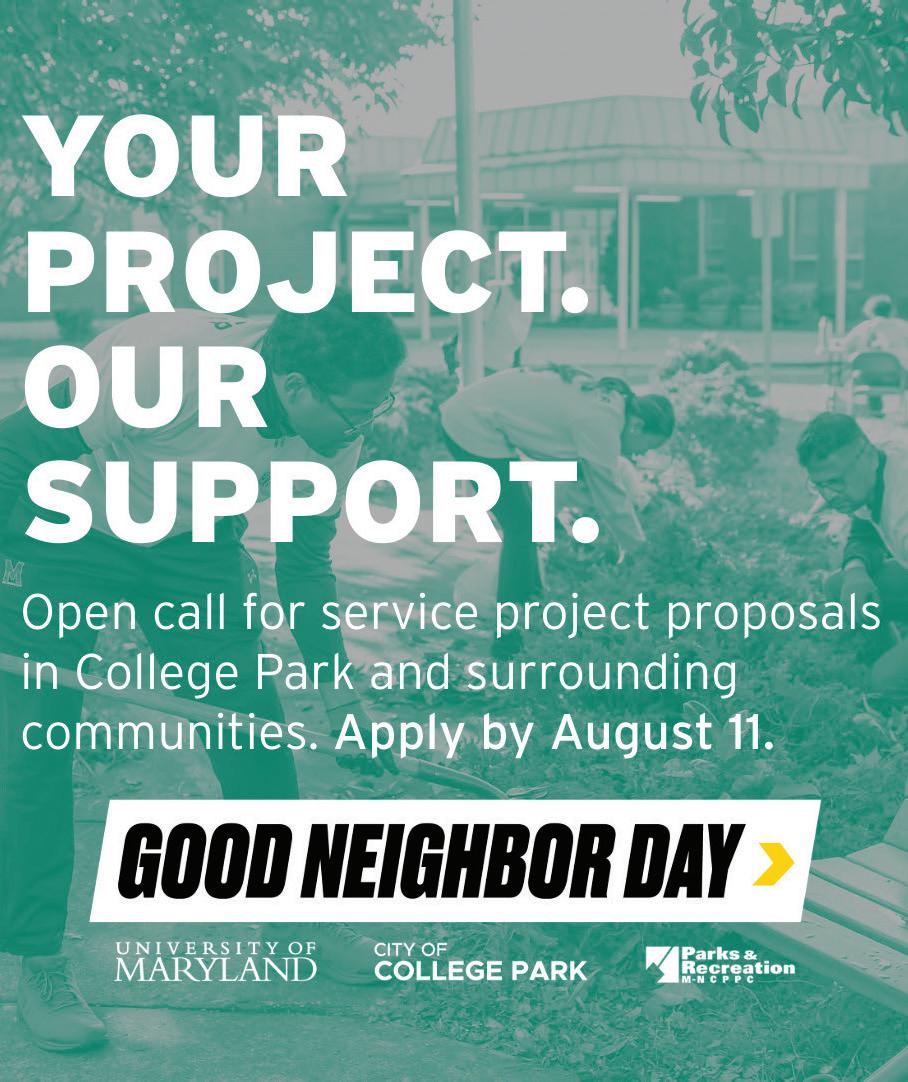
Our calendar includes many events and meetings sponsored by the City of College Park and local nonprofits, including arts organizations and performance venues. For additional events and meetings organized by the city, see the College Park Post newsletter in this paper’s centerfold. Please send notices of events taking place between Sept. 10 and Oct 8. to sam@streetcar suburbs.news by Sept. 5.
AUG. 6
National Night Out
Meet your neighbors and law enforcement officers at this community-police partnership event for residents and learn how to prevent crime and protect yourself. Free light refreshments and outdoor activities. 6:30 to 8:30 p.m. Duvall Field (9100 Rhode Island Ave.). For more information, contact the College Park Department of Public Services at 240.487.3570 or visit tinyurl.com/2f65ea42.
AUG. 9
Friday Night Live!
Enjoy a live concert with Uncle Jesse, a DMV-based cover band playing 1990s and 2000s hits. Free. Food and beer available to purchase. Free parking at the
downtown College Park parking garage. 6:30 to 8:30 p.m. City Hall Plaza (7401 Baltimore Ave.).
AUG. 14
Farmers Market Shop for fresh produce, baked goods, treats, wines, crafted goods and more at a mini market organized through a University of Maryland partnership with the Discovery District. 11 a.m. to 2 p.m. rain or shine. Located in the parking lot between 5825 and 5801 University Research Ct.
AUG. 15
Neighborhood Game Night
Join your neighbors for lawn games, music, crafts, challenges, prizes and more at College Park Woods Playground. Free. 6 to 8 p.m. 9119 Andrews Pl.
AUG. 17
College Park Aviation Museum: Egg Drop Challenge Splat or survive? Learn about the engineering process with the College Park Aviation Museum by trying to create a device to protect your egg from a 20-foot fall. Prizes will be awarded. $5. 11 a.m. to 12 p.m. 1985 Corporal Frank Scott Dr. To buy tickets, visit tinyurl.com/mvbdpery.
Award winners. Streetcar
Suburbs Publishing won 14 community journalism awards in the 2024 National Newspaper Association Better Newspaper Contest, including three for College Park Here & Now.
Columnist Rick Borchelt won first place among newspapers with similar circulations for best environmental story with “The spa in the spathe.” The judge commented, “Very interesting story on a plant lesser known than some of its cousins. Found ourselves continuing to want to read more.”
Designers Ashley Perks and Valerie Morris, who also lay out Hyattsville Life & Times and The Laurel Independent, won third place for best front page design. And writer Braden Hamelin scored an honorable mention for best profile feature story for his piece on Caleb Smith, a high school student and glider pilot. The awards honored work published in 2023.
Taco
renovations. The Diamondback quoted building permits that said the Mexican-inspired, fast-food restaurant is updating its HVAC system, lighting, and refrigeration and hood exhaust systems, and will have a redesigned façade and exterior paint when it reopens.
The documents did not say when the popular restaurant would reopen.
Campus Drive reopening. Sections of Campus Drive on the University of Maryland campus are set to reopen on Aug. 21, following months of closure over the summer.
Campus Drive and several other roads on campus and nearby were closed in late May and June for the ongoing Purple Line construction in College Park.
The closed sections of Campus Drive were located between Adelphi Road and Presidential Drive, and between Alumni Drive and Regents Drive. Union Drive, another road on campus next to Campus Drive, will also reopen on Aug. 21.
Memorial Chapel Open House
Come for a guided tour of the University of Maryland’s Memorial Chapel. Free. 10 a.m. to noon. Call (301) 314-9866 for more information. 7744 Regents Dr.
AUG. 18
Cooking class: Homemade Argentine-Style Empanadas Learn how to make Argentinestyle empanadas from scratch using a signature spice mixture with Chef Katriel at Shop Made in Maryland. Tickets $60. 3 to 5 p.m. 7401 Baltimore Ave, Suite D. For more information or to buy tickets, visit tinyurl. com/2hfpupjc.
AUG. 22
Neighborhood Game Night
Join your neighbors for lawn games, music, crafts, challenges, prizes and more at College Park’s Old Town Playground. Free. 6 to 8 p.m. 7504 Columbia Rd.
AUG. 31
College Park Aviation Museum: Runway Rhythms Experience the uniquely Japanese-American sound of contemporary beats combined with traditional taiko drumming from the COAST Taiko Ensemble in a summer concert at the College Park Aviation Museum.
Guests are welcome to bring picnic blankets or lawn chairs. Light refreshments available for purchase. $2 to $5. Free for children 2 and under. 1 to 2:30 p.m. 1985 Corporal Frank Scott Dr. For more information, visit tinyurl.com/2x82k9tu.
SEPT. 6
Opening reception, “Dewey Crumpler: Life Studies” Attend the opening reception of artist Dewey Crumpler’s solo show, “Dewey Crumpler: Life Studies,” at The David C. Driskell Center at the University of Maryland. Free. 5 to 7 p.m. RSVP online at tinyurl.com/5658n5sb.
Friday Night Live!
Enjoy a live outdoor concert featuring Friday Night LIGHTS. Arts and crafts and activities will be available for children. Food and beer for purchase at the event. Free. Free parking at the downtown College Park parking garage. 6:30 to 8:30 p.m. City Hall Plaza (7401 Baltimore Ave).
SEPT. 4-10
NextNOW Fest 2024
Attend various events at the University of Maryland’s annual multi-day arts festival featuring live music, workshops, comedy performances and visual
artwork. Lineup of events will be announced on Aug. 19. Free. UMD campus. For more information visit tinyurl.com/ wp9hkrwb.
College Park Community Library Children’s Story Time Meet on the lawn for a children’s story time on sunny days. In rainy conditions, the event will be held inside. Free. Wednesdays, 9:30 to 10 a.m. College Park Church of the Nazarene, 9704 Rhode Island Ave.
Line Dancing with Jessie Join Jessie Barnes of Jessie’s Soul Line Dancers every Friday from 10 to 11 a.m. for an online — and energetic — line dancing workshop offered by the College Park Arts Exchange. All ages and skill levels are welcome. Free. Visit tinyurl.com/2tj279n4 for more information.
Tai Chi Class
Learn the ancient Chinese form of slow-moving meditation with Maureen Stone and Mark Grisar Wednesdays from 10 to 11 a.m. $10 for one class; $35 for four. Old Parish House, 4711 Knox Rd. For more information or to register, visit tinyurl. com/28cf82bb.
Suspicious person. Prince George’s County police questioned a man they said has been trying to open car doors in College Park’s Calvert Hills neighborhood. In correspondence shared with residents by City Councilmember John Rigg (District 3), police said the man’s mother described him as mentally ill and not taking his medications.
Still, police said attempting to open car doors is not a crime and asked residents to call 911 if he enters a vehicle or commits another crime.
Special election. Only one of the 12 candidates running for the open Prince George’s County Council seat had raised more than $5,000 in campaign funds by July 19, according to campaign finance reports filed with the state July 26.
The special election primary date is Aug. 6, and the general election will be Nov. 5.
The candidates will compete to replace former Prince George’s County Councilmember
Mel Franklin (At-Large), who resigned in June amid charges of embezzlement, felony theft scheme and perjury.
For coverage of the candidates’ campaign finances, visit streetcarsuburbs.news.
New exhibit. The Field of Firsts Foundation, a nonprofit supporter of the College Park Aviation Museum, received a $50,000 grant from the Maryland Heritage Areas Authority
to create and display an exhibit at the airport about Black aviators.
The airport project was one of three in Prince George’s County to share $185,000 in funding. An award of $100,000 will go toward converting a 1930s-era firehouse in Cottage City into a center for film production and visual arts, and Greenbelt received $35,000 for a research project to identify those interred in three city-owned cemeteries.

By BODE RAMSAY
Now that the State Highway Administration (SHA) has finished extending the Rhode Island Avenue Trolley Trail to the Anacostia Tributary Trail in Hyattsville, some local officials said they want to take it farther.
The College Park City-University Partnership plans to spend $3 million to build an off-campus bike lane along Campus Drive that will connect to cam-
pus and to the Trolley Trail, according to Executive Director
Susan Slingluff Hartmann.
And College Park Mayor Fazlul Kabir said he hopes future improvements eventually will extend the trail north to Beltsville.
“Maybe in the future we could extend even beyond College Park, because bicycle transportation is not that great once you go past [here],” Kabir, a cyclist himself, said. “Beltsville is very dangerous, actually, to bike, so that’s something we’ll be advo-
cating for.”
The Trolley Trail runs 3.8 miles south from College Park to Hyattsville. Its southern end in Hyattsville was completed in late 2023, giving users a direct route — via connecting trails — all the way to D.C.
Hartmann said she hopes adding the bike lane along Campus Drive will encourage more student use.
Kabir said he wishes to encourage more cyclists and pedestrians to use the trail in Col-
lege Park as an alternative form of transportation.
The Trolley Trail was built directly over a streetcar line, which half a century ago ran from the Department of the Treasury, in downtown D.C., all the way north to Laurel. The trail has served area residents since 2002, when the first section opened in College Park.
Over the years, the College Park City-University Partnership has added security cameras and lighting in dark areas to improve trail safety.
The partnership is also working to install art projects across the Lakeland portion of the trail, according to Hartmann.
“[The goal] is to make it a beautiful art walk — to bring public art and enliven the space,” she said.
destrian and cyclist safety.
The SHA constructed a 10foot wide, half mile-long path and buffers stretching from Farragut Street to Charles Armentrout Drive to connect the Trolley Trail to the Anacostia Tributary Trail.
The path, with grass buffers separating it from the street, creates an alternative for those wishing to travel into D.C. without using public transportation or a car.
The project was part of the state’s Pedestrian Safety Action Plan, which aims to reduce and ideally eliminate traffic-related injuries and deaths.
•
•
•
•
•
•
•
Kabir said he would like to place a map and a way-finding sign along the College Park stretch of the trail, similar to the neon one in Hyattsville, to direct potential new users to the trail.
“The idea is to give residents information that there are ways other than taking your car,” Kabir said.
The $6.4 million extension in Hyattsville, which was completed in December, is the trail’s most recent update. The extension includes features to enhance pe-
“Here in Hyattsville, we’re providing features and improvements that meet community needs by creating a safe, accessible, world-class connection to Prince George’s County’s trail network,” Maryland Transportation Secretary Paul J. Wiedefeld said in a statement. “That, in turn, encourages even greater pedestrian and bicycle mobility.”
According to the SHA, this project is the last of the state’s scheduled work on the Trolley Trail .
Kabir said that although College Park officials have started talking to the county about potential local improvements, they have no funding at this time.
By SHARON O’MALLEY
The College Park City Council in July directed its staff to come up with a proposal to allow 16- and 17-year-old residents to vote in city elections.
At the same meeting on July 9, councilmembers declined to continue a decade-old effort to lengthen their terms from two years to four.
In a non-binding advisory question on the November 2023 ballot, College Park residents favored four-year staggered terms for the mayor and councilmembers.
“This is something that we’ve been discussing for the better part of 10 years,” Councilmember John Rigg (District 3), said at the meeting. “We are one of the few municipalities of any size that has two-year terms.”
Rigg said councilmembers “are substantially less productive every other year when we have an election because we have to make time in our otherwise busy part-time [council] jobs to also run for re-election while trying to govern the city.”
He conceded that switching to staggered four-year terms would not save city staff any time because elections would still be held every two years, but with fewer candidates.
Plus, Rigg said, figuring out how to stagger terms in an equitable way “is a messy one” because during the first election of the new system, some candi-
dates would be assigned fouryear terms, while others would run for only two years.
Voters also weighed in on the issue in 2019, when they responded to an advisory ballot question by saying they favored two-year terms.
In a straw poll during the meeting, six councilmembers said they did not want staff to bring a proposal to the council for more discussion and a possible vote, while two, including Rigg and Councilmember Alan Hew (District 1), endorsed a second work session on the issue.
In a second straw poll, councilmembers decided 5-3 to schedule a future discussion that could lead to allowing 16and 17-year-olds to register to vote in city elections.
Rigg said he supports registering teenagers to vote, noting the younger they start participating in elections, the more likely they will regularly vote as adults.
Past University of Maryland student liaisons to the council “were constantly fretting over how they just had problems getting, especially freshmen and sophomores … to the polls,” Rigg said. “A lot [of] them just don’t feel compelled to vote at all because it’s not something they’ve ever done. … They went to college before they really had a chance to participate in a meaningful election in a lot of cases.”
Rigg noted that few 16- and 17-year-olds would be likely to vote if the city allowed it, and therefore would be unlikely to sway an election.
“As a matter of mathematics and a matter of political economy, there’s only about 300 residents ages 16 and 17 in the city,” he said, citing U.S. Census Bureau statistics. He estimated that approximately 8% of College Park residents vote. “If you assume that we got 8% of that 300, what we’re really talking about are, like, a couple dozen voters.”
Rigg added, “I’ve only heard upside on this. … We will hear opposition from some residents who are just leery of any kind of change and/or who are naturally suspicious of younger people.”
Still, he added, expanding the voting age “strikes me as a pretty good idea with very little downside.”
Councilmember Maria Mackie (District 4), said she polled her five adult children, who said they would not have been ready to vote at age 16.
“They all said no, we wouldn’t want to vote when we were 16 or 17. [They] didn’t feel that they had the education and the ability to make the best decision” at 16, Mackie said, noting she would rather develop a youth advisory council “to get them involved but not necessarily give them a right to vote.”


While the voting age in most of Maryland is 18, state law allows local city councils to lower it in their municipalities. Five cities, including Greenbelt, Hyattsville, Mount Rainier, Riverdale Park and Takoma Park, allow 16- and 17-year-olds to vote in local elections. Seventeenyear-olds may vote in all Mary-
land primaries, as long as they will turn 18 before the general election.
According to Vote16USA, a national group that advocates for a lower voting age for local elections, teenagers in those five Maryland cities turn out on Election Day in greater numbers than older voters.
The University of Maryland’s Legacy Leadership Institute on Public Policy is looking for volunteers age 50+ to serve during the 2025 session of the Maryland General Assembly. Classroom training begins on September 16, 2024, two days per week at the College Park campus, with site visits to the state complex in Annapolis. The volunteer assignment will be for a minimum of two days per week, starting in January 2025, in the Annapolis offices of various senators and delegates.
For more information or an application, contact Wesley Queen at wqueen@umd.edu or call (301)-405-2529



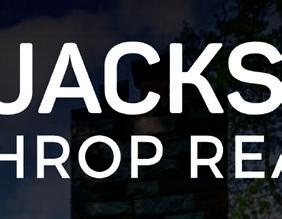

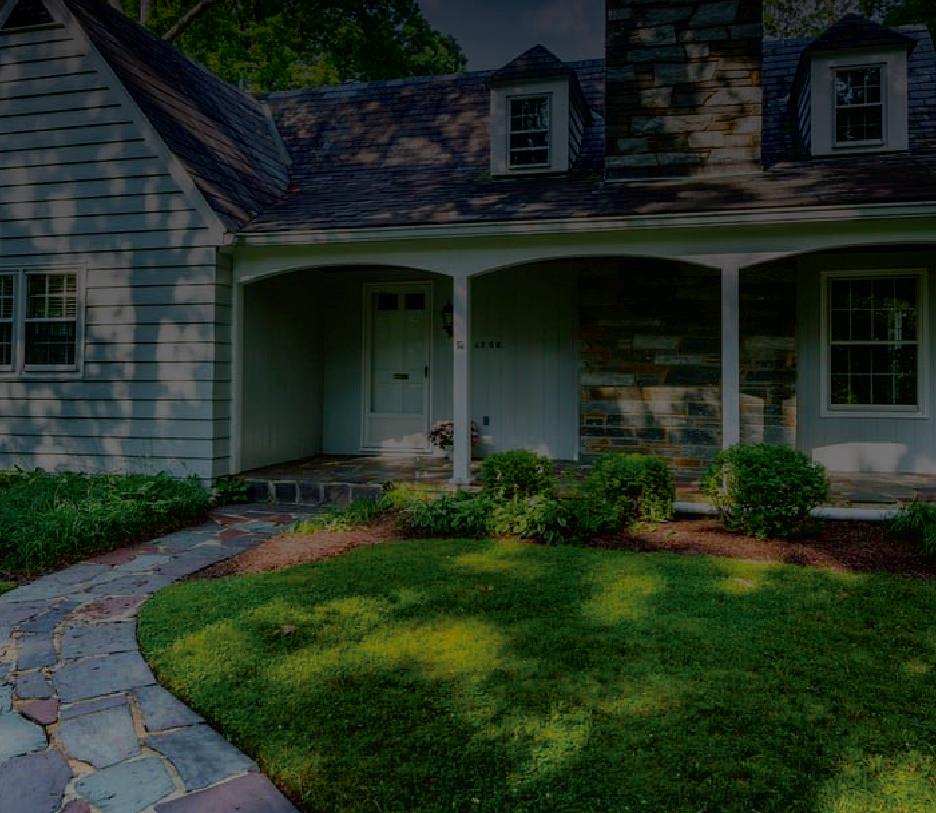



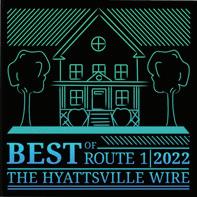
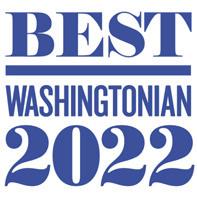

covery Funds to governments across the country to respond to the challenges of the COVID-19 pandemic.
“Without question, that was something unprecedented in the City of College Park,” College Park City Councilmember Stuart Adams (District 3) said.
Adams said the council decided to “substantially allocate” and spend most of the federal funding by fiscal year 2024. The city so far has spent $19 million and must use the remaining $3 million by Dec. 31, 2026.
Across the country, cities of all sizes received a collective $65.1 billion, according to Julia Bauer, the research and data analysis program manager for the National League of Cities.
“I think a lot of people were very excited at the beginning of this whole project,” Bauer said. “We found less than 1% of cities declined funds, so for the most part, it was something that people were very happy to receive.”
Initially, most cities focused on public health, purchasing personal protective equipment (PPE) like masks and sanitizer, Bauer said. College Park spent about $95,600 on PPE and on enforcing rules to prevent large gatherings, according to city data. It also gave $375,000 in assistance to the Berwyn Heights, Branchville and College Park fire departments.
“They played an absolutely critical role in addressing COVID and recovering from COVID,” Adams said. “Not only do they provide fire service, but their [emergency medical technician] ambulatory services, that’s really, absolutely critical to the health and safety of College Park.”
The Treasury also authorized use of funds for other expenses that were not directly health related. Governments were allowed to use money for economic programs, financial assistance and infrastructure.
Mayor Fazlul Kabir said the city council focused on using ARPA funds to help residents and to restart the local economy.
To achieve this, one of the city’s main focal points was helping small businesses, nonprofits and the tourism industry.
Small businesses saw the most of that group, receiving $1.7 million. On average, each business that applied and was approved received $20,000, according to the city’s economic development department director, Michael Williams. The city also allocated $62,350 to nonprofit organizations.
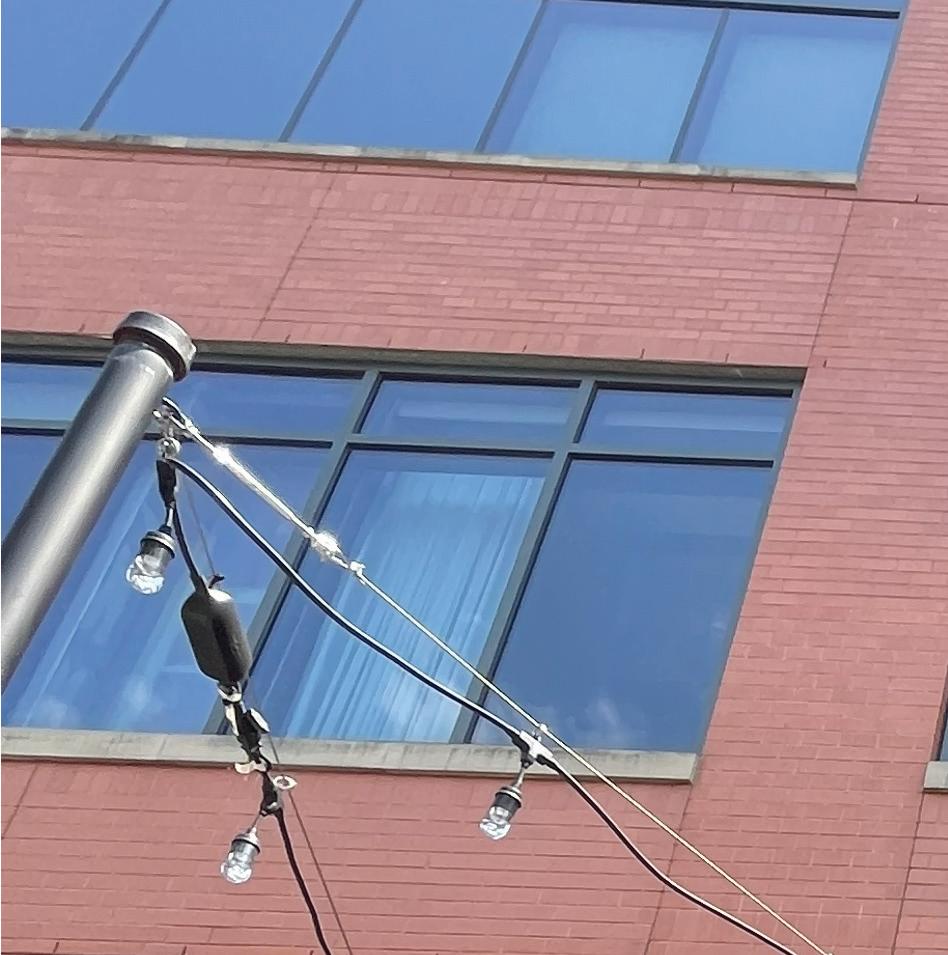
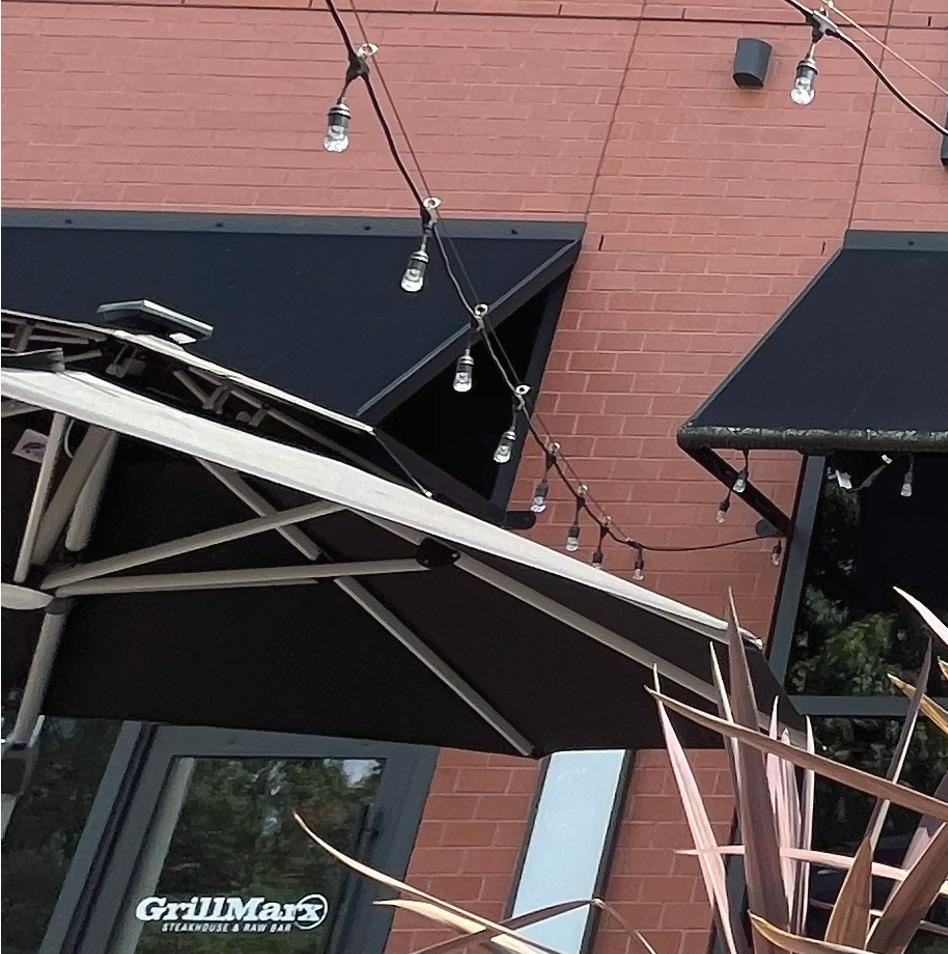
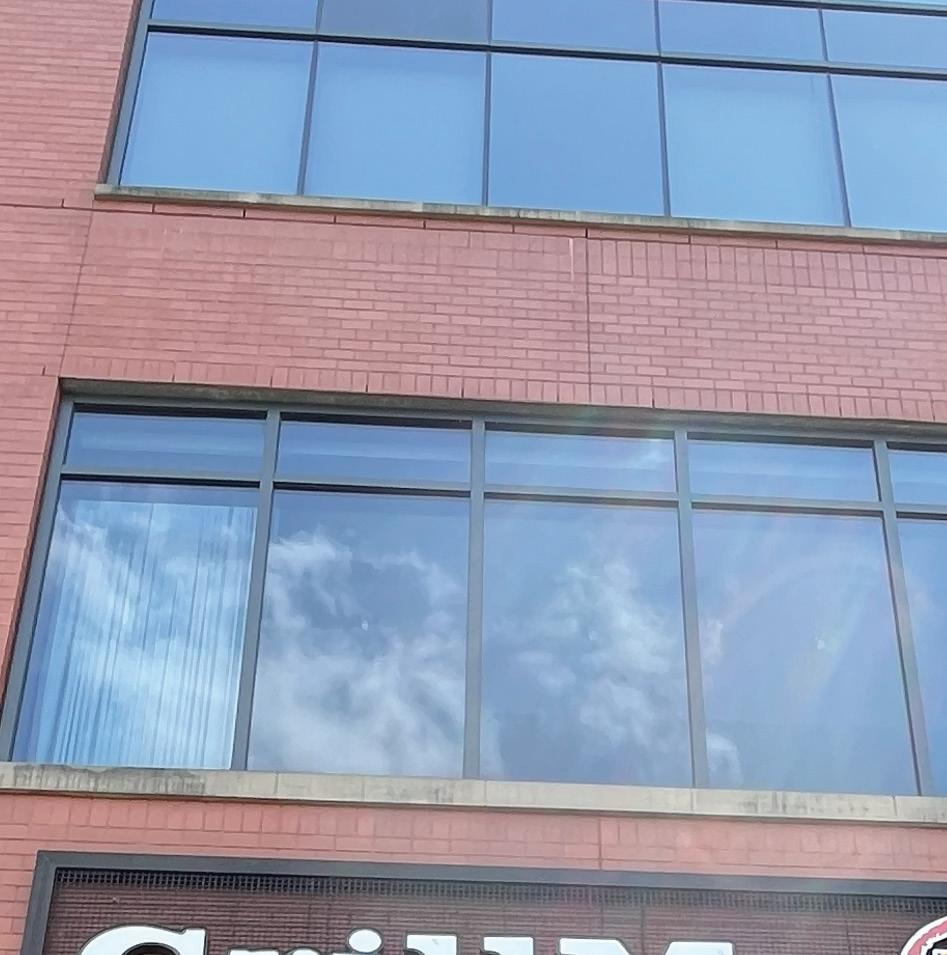
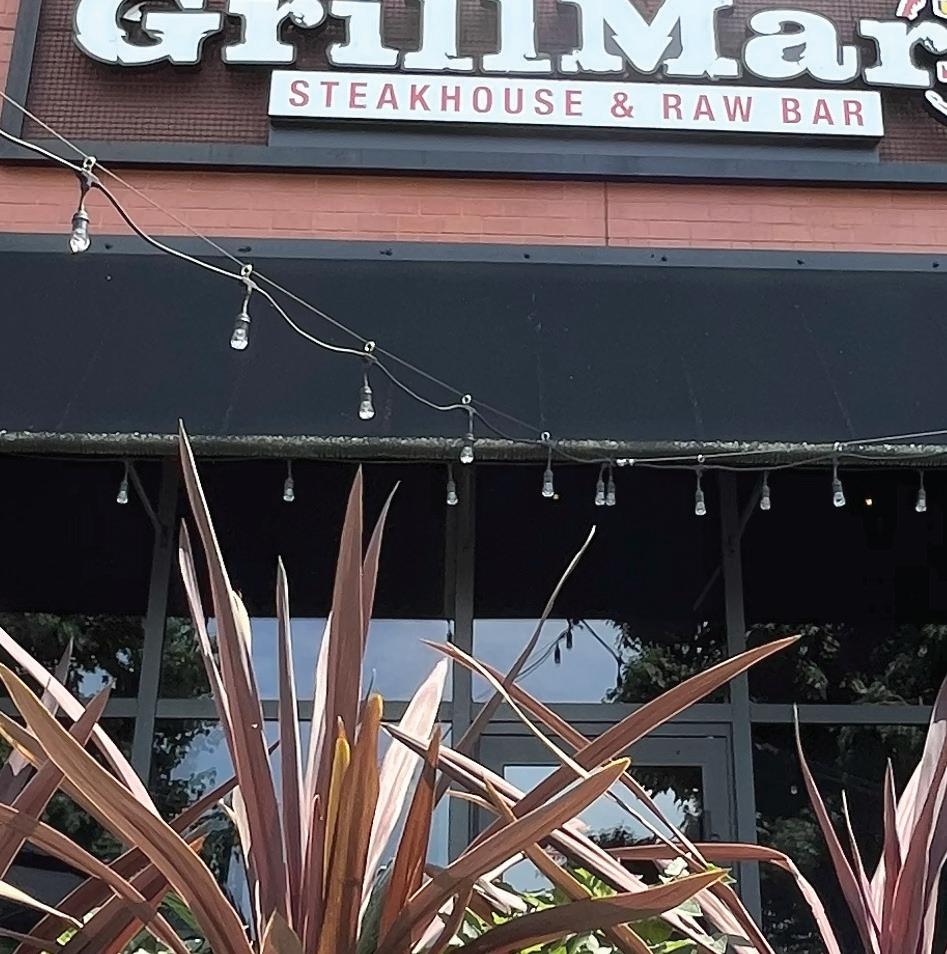

“The word throughout the ARPA process was always impact,” Williams said. “Were they severely impacted? Did businesses close up? Did they basically lose their employees?”
Williams added: “During COVID, we were able to help financially, but the [small business] owners also came out and became a little bit more open about what their challenges are. We actually got a better relation with many of the owners, big or small.”
The tourism and hospitality industry received $450,000 in grants. The Hotel, the Holiday Inn, and other hotels and some restaurants throughout the city received this aid.
The Hotel “is a vibrant hotel that we want to succeed because the economics make really good sense for College Park,” Adams said. “When that hotel succeeds, it brings in a lot of tax dollars, both property tax and occupancy tax.”
In addition, the city used some of the $10 million it received in ARPA recovery funds to bring new restaurants, like Iron Rooster and GrillMarX, to College Park. Both restaurants are in the retail space on the street-level floor of The Hotel.
The city was allowed to spend this money where officials deemed it was necessary, as long as it was within the Treasury’s allotted time frame, ac-
cording to Adams.
The other main focus for the city, according to Kabir, was helping families and individuals with financial struggles by funding free food services, offering financial assistance for rent and utilities, or creating or bringing new jobs to the city.
Food services, like Meals on Wheels and the College Park Community Food Bank, received $1 million of assistance from the city.
The city also offered a little more than $250,000 in emergency assistance to households struggling to pay rent or utility bills.
Some 86 households received assistance, according to Gary Fields, director of the city’s Department of Finance. On average, the city paid about $3,000 to each of those households for expenses like past-due rent, mortgage payments, utilities, car payments and medical bills, Fields said.
In light of those struggles, the city also offered up to $5,000 to compensate residents who sought mental health services. Almost $55,000 worth of the funds were allocated for this purpose.
The city also invested the money in affordable housing initiatives, including renovations at Attick Towers, an apartment building for senior citizens, for $1.25 million.
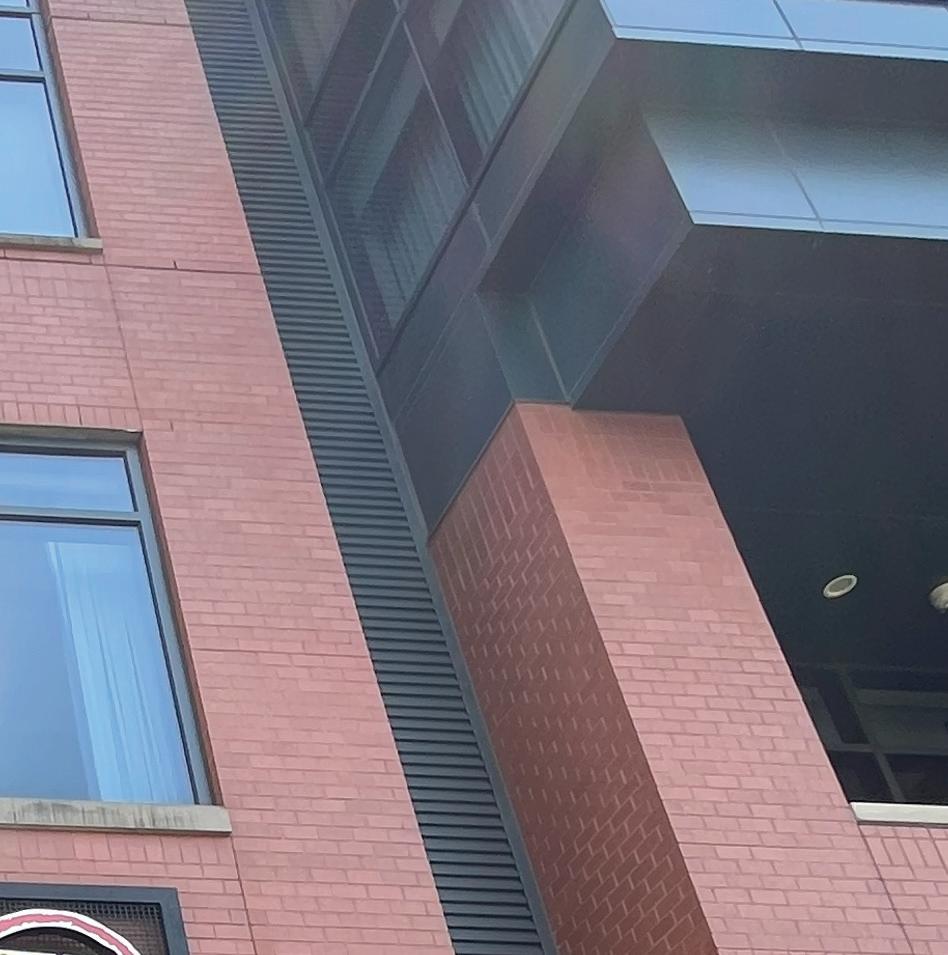
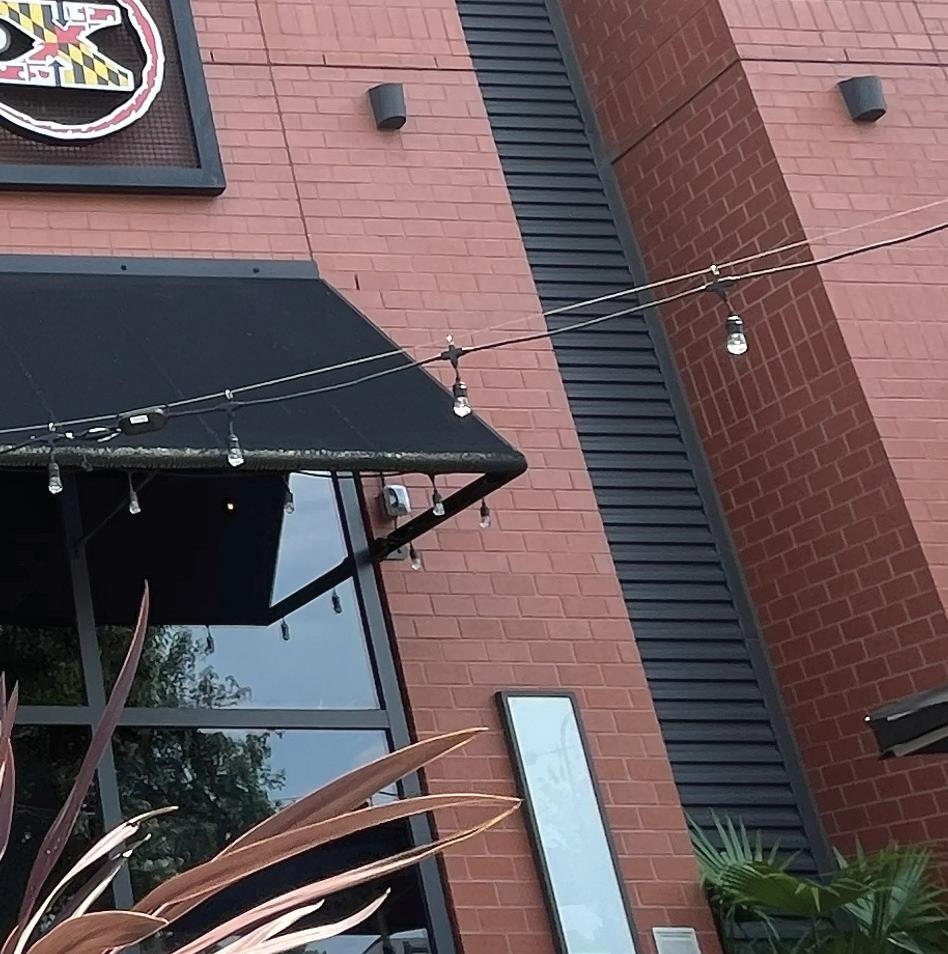

“Just as the pandemic exacerbated some issues, it showcased the need to upgrade those facilities,” Adams said. “That’s to support some of our most vulnerable and affordable housing in College Park.”
Along the same lines, the city invested $3 million in the College Park Community Preservation Trust, a land trust organized by the College Park City-University Partnership that finds and buys local homes to resell at an affordable price to income-eligible households.
“We’re excited because this is part of the goal we have to bring affordable housing to College Park,” Kabir said.
The city also spent $639,709 on infrastructure, including a stormwater assessment project.
“The purpose was to invest in things like building sidewalks and making new projects that would be creating jobs and bringing jobs to the local community,” Kabir said.
Improving infrastructure could help to negate harmful impacts of the pandemic, Adams said. Families that struggled during the pandemic might have a harder time recovering from potential flood damage, for example, he said.
“I think the whole point of ARPA was to help communities through the pandemic while also addressing inequities that
the pandemic further exacerbated,” Bauer said.
The remainder of the allocated money, $300,000, went toward administrative expenses, including consulting and management of the new programs.
Some of the already-allocated money may be reallocated before the deadline at the end of next year, according to Fields.
Kabir said he would like to continue to support many of the projects that began during the pandemic, such as giving money to food services and offering financial assistance to homeowners. However, the mayor said, funding will likely be at lower levels than it was during the pandemic when ARPA money was available.
“My colleagues and the mayor have, at least in this [fiscal year 2025] budget, substantially maintained new programs that were started with ARPA funding, but now they’re transitioning to using general tax dollars,” Adams said.
But, Kabir said, the city “might need to adjust the level a little bit in the coming years as they move forward.”
Other expenses, like the $3 million investment into the housing trust, were “a one-time thing,” he added.
“We had the opportunity, and we invested it,” Kabir said. “We made the right decision.”
3711 Campus Drive on the street level of the Domain College Park apartment building. “Instead of ice cream that is made and stored in a freezer, we actually make it fresh in front of you.”
At the shop, customers can order flavors ranging from Oreo Secret, a fan favorite, to Reese’s Blast and Mango Tango.
Customers can walk around the counter to watch employees make their ice cream on a freezing tray while they wait. The employees use a base flavored with vanilla, chocolate, coffee, Thai tea or matcha, and then crush toppings and mix them in.
Once the process is finished, the employee rolls up the ice cream into swirly cylindrical pieces and adds them to a bowl before smothering the concoction with whatever toppings the customer requests.
The rolled ice cream has a texture that is a bit thicker than normal but retains the same smooth, refreshing flavor, according to employees.
Maryland Dairy, an ice cream icon on the UMD campus, is another top choice for ice cream connoisseurs. The Dairy, located in the food court at the Adele H. Stamp Student Union, has famously been making ice cream at various campus locations for
not see any change, while 16% will have a bell time shift of between 16 and 45 minutes.
Last year, the school system had 13 morning start times compared with three this year and 17 dismissal times compared with six for the coming school year.
College Park parent Kelsey Easter, who has children at Robert Goddard Montessori in Seabrook, said while the new 9:30 a.m. start time will be only 15 minutes later than last year, it





more than 100 years.
The store features unique flavors – some named after UMD coaches and staff – like Brenda’s Peanut Butter Frese, for women’s basketball coach Brenda Frese, and Sasho’s Crew Crunch, for men’s soccer coach Sasho Cirovski.
“I always hear, ‘I’m excited [to have the ice cream],’” Stephen Proctor, a supervisor at Maryland Dairy, said of the store’s customers. “A lot of people come in here and it makes them more happy by the time they leave.”
Ice cream lovers can find familiar favorites at a number of national chain stores with branches in the city.
Cold Stone Creamery, located locally in the College Park Shopping Center next to the campus, serves ice cream at more than 1,000 locations around the world.
At the College Park location, a favorite flavor is Oreo Overload, according to worker Daisy Arguello. Other top sellers are sweet cream and vegetarian ice cream, Arguello said.
For night owls looking for cookies and ice cream, Insomnia Cookies on College Avenue, open until at least 1 a.m. every night, is a frequent stop.
Best known for its chocolate chunk and Snickerdoodle cookies, Insomnia Cookies also serves a unique blend of ice cream.
“Our ice cream flavors are unique because we use our cook-
could cause difficulty for parents with inflexible work schedules.
“I know it’s only 15 minutes, but for parents who have to work in an office or have a commute, that’s tough on them, and then in the evening, our bus routes are notoriously long,” Easter said. “Some kids are on the bus for an hour and a half to two hours in the morning and in the evening.”
Emmett Hendershot, the principal of Paint Branch Elementary in College Park, predicted an adjustment period to the school’s new 8:30 a.m. start time,















ies [in the ice cream],” Assistant Manager Bethany Wilson said.
Some customer favorites are Cookies ’N Dream and salted caramel. The shop also offers sundaes that feature ice cream scoops on top of the store’s cookies or brownies. Customers can also buy ice cream by the pint.
Located inside of a Dunkin’ Donuts, Baskin-Robbins in north College Park brings its own twists to classic ice cream flavors.
“This new ice cream we’ve got called Beach Day is pretty unique,” Brian Ramirez, an employee, said. The light bluecolored ice cream features tiny, caramel-filled sea turtle candies and bits of graham crackers. “It’s one of the favorites.”
For an alternative to ice cream, some dessert seekers visit Rita’s Italian Ice & Frozen Custard in north College Park.
Although well known for its custard and shaved ice, Rita’s also serves its own version of gelati, a mixture of custard and ice.
“We’re known for our gelatis,” Muhammad Haroon, the store manager, said. “Our most popular flavor is mango with vanilla custard.”
Haroon said business has been better than ever this summer, with the store seeing a 4% increase in sales compared with past summers.
“It’s a lot hotter than last year,” Haroon said.
but said he doesn’t foresee a major impact on instruction. The school opened at 9:15 a.m. last year.
PGCPS has been affected by a national bus driver shortage, which meant some drivers had to take on multiple routes, leading to delays in arrival times, McCawley said in an email.
Jenni Pompi, vice president of Eleanor Roosevelt High School’s

Ice Cream Jubilee 4430 Calvert Road
Hours: Noon to 9 p.m. every day
Class 520 3711 Campus Drive Hours: 1 p.m. to 9 p.m. every day
Maryland Dairy Hours: Noon to 5 p.m. Monday to Friday. Closed on weekends during summer
Rita’s 8900 Baltimore Ave. Hours: Noon to 10 p.m. every day
PTSA, said she has seen buses arrive so late that “kids were missing … almost the entire first-period class.”
Pompi, whose older son is a rising senior at Eleanor Roosevelt High School in Greenbelt, also has a 10th-grader at Parkdale High School in Riverdale. She said she occasionally had to drive her younger son home from school because the bus
Cold Stone Creamery
7314 Baltimore Ave.
Hours: Noon to 10 p.m. Sunday to Thursday; Noon to 11 p.m Friday and Saturday
Insomnia Cookies
4513 College Ave.
Hours: 11 a.m. to 1 a.m. Monday to Wednesday; 11 a.m. to 3 a.m. Thursday to Friday; Noon to 1 a.m. Sunday; Noon to 3 a.m. Saturday
Baskin-Robbins
9701 Baltimore Ave. 5 a.m. to 8 p.m. every day
never showed up in the afternoon.
In addition to introducing the new times, PGCPS is relocating some bus stops and eliminating others; ending bus service for students who live within a safe walking distance to school; allowing families to opt out of bus service; and improving the ability of parents to track the location of their children’s buses.






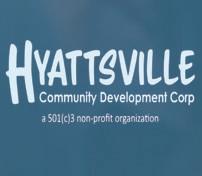



By LILLIAN GLAROS
Like many of her neighbors at Spellman House Apartments in Lakeland, 73-year-old Carolyn Sims has a shelf outside of her unit filled with flowers and trinkets. She keeps a couple of walkers indoors to help her get around, and her pill bottles sit on the side table next to her armchair.
Health issues make it difficult for Sims to get around. That’s where a College Park-based organization, Neighbors Helping Neighbors, steps in, sending volunteers to drive her to doctor appointments, the grocery store and neighborhood events.
“Oh, I’m thankful, real thankful,” Sims said. “It’s awesome.” Sims, who signed up for the free service in 2020, enlists the help of volunteers two or three times a month. She also likes making friends with the volunteers who assist her, like Mary Anne Hakes. Hakes, a Calvert Hills resident and co-chair of College Park’s Senior Advisory Committee, has been volunteering for Neighbors Helping Neighbors since the or-

ganization started in 2018 to assist College Park residents who are disabled or older than 55 with errands, household chores and yard work, like raking leaves.
“The idea is to allow people to age in place, so that if they have reached a point where, because of illness or age or something, they can’t drive, we don’t want them to have to leave the community if that’s not their wish,” Hakes said. “So if we can do things to help them, like grocery shop and
things like that, we’d like people to remain in their homes as long as they want to.”
Some of the most common tasks for Neighbors Helping Neighbors volunteers are lawn maintenance and rides to medical appointments and grocery stores, according to Paula Greene, who coordinates the nonprofit’s volunteers. The organization also helps fill a social void, as Greene calls the clients once a week to check up on them.


“Sometimes I’m on the phone an hour just listening to them talk,” Greene said.
She said she never rejects a request unless no volunteer is available.
“If someone will call and say, ‘I need to get my car washed,’ well, I would tell them I’m going to put it out there, but I’m not sure if a volunteer will pick it up or not,” Greene, a Riverdale resident, said, “so I let them know, but I always take their requests.”
Summer is the busiest season for the service, which helped 11 clients in June and 58 so far this year.
One of the organization’s main challenges is finding volunteers, Greene said. Neighbors Helping Neighbors currently has 16 volunteers.
“We still struggle with having … the right volunteers to meet the needs of the members,” Robert Thurston, the chair of Neighbors Helping Neighbors’ board of directors, said.
“Some people, they’re looking for opportunities to help others, and some people need support from others,” Scheckel, a Beltsville resident, said. “So if we can get people together to do that, then it’s going to be best for everybody.”
The city pays for operating costs and Greene’s compensation, and the Rockville-based Jewish Council for the Aging (JCA) provides operational support for volunteer training and ride scheduling software, Thurston, who lives in College Park’s Lakeland community, said. Neighbors Helping Neighbors participates in the JCA’s VillageRides program, which partners with communities to offer transportation to seniors and those with disabilities.
“At some point, if we’re lucky, we all will get old – and [we’ll] need some assistance to help us manage our day-to-day lives,” Thurston said. “I’m hoping that we will develop an army of people that see that need … to help their neighbors stay in their homes as long as they can.”
Volunteer Donald Scheckel, a new member of the board, said he enjoys all the tasks he does, from chatting with clients while driving them to appointments to raking leaves in their yards.



